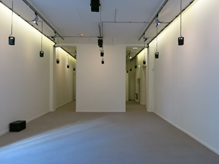
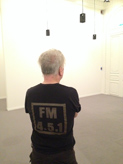
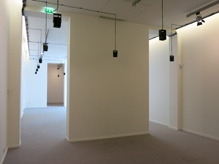
L’EXPOSITION D’UN RÊVE
7 octobre – 17 décembre 2017
Les rêves de Gabriel Abrantes, Genesis Breyer P-Orridge, FM Einheit, Tim Etchells, Alexandre Estrela, Susie Green, David Link, Pierre Paulin, Emilie Pitoiset, Lee Ranaldo, Susan Stenger et Apichatpong Weerasethakul
Interprétés par FM Einheit avec Volker Kamp, Robert Poss, Susan Stenger, Erika Stucky, Saskia von Klitzing et les chanteurs du Choeur Gulbenkian
Joués à travers les Mandalas de José de Almada Negreiros, Philippe Decrauzat, Myriam Gourfink, Olivier Mosset et Eduardo Terrazas
Une exposition de Mathieu Copeland



Cette exposition a été pensée dans un lieu très précis : le jardin Gulbenkian. Conçu par António Viana Barreto et Gonçalo Ribeiro Telles dans les années 60, le jardin encadre actuellement le bâtiment où le rêve de Calouste Gulbenkian prend forme chaque jour.
L’exposition telle qu’elle se propose s’inspire littéralement des rêves de cinéastes et de dramaturges, de poètes et d’écrivains. Leurs rêves ont été mis en musique par le musicien allemand F. M. Einheit puis enregistrés à la Fondation et dans son jardin, grâce à la contribution de nombreux musiciens et du Chœur Gulbenkian tout au long de 2017.
Un intéressant dialogue s’offre ici : le rêve et l’immatérialité d’une exposition et la matérialité très concrète d’une institution comme la Fondation Gulbenkian. L’architecture, l’institution, le jardin, selon les mots du commissaire Mathieu Copeland viennent « renseigner l’exposition et, en retour, l’exposition utilise l’institution ».
Le rêve – en tant que manifestation des désirs et des peurs (dans une lecture freudienne), support des voix de l’inconscient (parfois de voix de l’autre monde), mais aussi outil de création, le rêve comme élément constitutif de mythologies – est le fil conducteur de cette exposition.
Parallèlement, les abstractions géométriques (cf. Almada Negreiros) ou mystiques (les mandalas, des diagrammes symboliques qui jouent un rôle dans de nombreuses traditions religieuses ou même dans l’école jungienne de psychologie) tiennent ici une place importante. Ce projet donne lieu à ce que le commissaire appelle polyphonie, conçue par un « auteur-multiple », explorant les dimensions de l’immatérialité d’une exposition.
Exposition ouverte lundi, mercredi, jeudi et vendredi de 9h à 18h
Samedi, dimanche et jours fériés de 11h à 18h
--
Rencontre avec Mathieu Copeland et FM Einheit autour de L'exposition d'un rêve
Jeudi 16 novembre, 2017 - 19:00 Jusqu'à 20:30
Lors de cette discussion, Mathieu Copeland, le commissaire de L’exposition d’un rêve, et FM Einheit, le compositeur des chansons à partir des rêves de douze artistes, présenteront et discuteront de l’exposition, et reviendront sur l’ensemble de la carrière de FM.
Mathieu Copeland (né en 1977, vit à Londres) cultive une pratique curatoriale cherchant à subvertir le rôle traditionnel des expositions et à en renouveler nos perceptions. Il a notamment été co-commissaire de l’exposition «Vides, une rétrospective » au Centre Pompidou à Paris en 2009 et à la Kunsthalle de Berne et a récemment édité « The Anti Museum », co-publié par Koenig Books en 2017. Il a été commissaire invité du Musée du Jeu de Paume, Paris (2013-2014) et, avec Philippe Decrauzat, commissaire invité du Plateau – FRAC Ile-de-France Paris (2014-2015).
FM Einheit (né en 1958) est un musicien, compositeur et performeur allemand, pionnier de la musique industrielle. Co-fondateur du mythique groupe allemand Einstürzende Neubauten, il poursuit aujourd’hui une intense carrière solo qui allie l’énergie et l’urgence du mouvement punk aux expérimentations issues de la musique bruitiste. FM Einheit a enregistré de nombreux albums et collaboré notamment avec Diamanda Galás, Andreas Ammer, Pan Sonic, Gry ou encore Caspar Brötzmann.
La conversation aura lieu en anglais.
UNA EXPOSICIÓN COREOGRAFIADA
16 SEPTIEMBRE — 15 OCTUBRE 2017
INAUGURACIÓN 16 SEPTIEMBRE 11:00
UNA EXPOSICIÓN DE MATHIEU COPELAND
Una exposición coreografiada consta únicamente de movimientos. Reúne las obras coreografiadas para la exposición por artistas, coreógrafos y músicos de fama internacional. Durante un mes, tres bailarines ocupan constantemente los espacios de exposición e interpretan una coreografía de gestos, figuras y desplazamientos, con arreglo a las partituras e instrucciones escritas por Cecilia Bengolea, Fia Backström, Jonah Bokaer, Tim Etchells, Karl Holmqvist, Jennifer Lacey, Roman Ondák, Michael Parsons y Michael Portnoy.
En ausencia de decorado, luz dramática y música, los gestos "resuenan" en las galerías vacías del CA2M, donde los bailarines centran toda la atención. Lo único que acompasa las representaciones son los horarios de apertura del centro de arte y la duración de la exposición. Los gestos, encadenados en un continuum sin fin, se convierten en formas abstractas y flotantes que se despliegan y vagan por el espacio.
La relación con el espectador queda profundamente alterada: ya no es él quien da vueltas alrededor de las obras, sino ellas las que dan vueltas a su alrededor y le arrastran con su impulso. La proximidad turbadora de los bailarines y sus desplazamientos, a menudo imprevisibles, le obligan a ponerse él también en movimiento, a cambiar permanentemente de posición.
Una exposición de Mathieu Copeland que se forma y evoluciona a lo largo del tiempo y solo se fija en la memoria, porque al final lo único que queda es el recuerdo de los gestos efectuados.
Una exposición coreografiada es una coproducción original de la Kunsthalle de St Gallen (Suiza) y de la Ferme du Buisson, de Noisiel (Francia), donde la exposición se celebró, respectivamente, del 1 de diciembre de 2007 al 13 de enero de 2008 y del 8 de noviembre al 21 de diciembre de 2008. La muestra es un hito importante en la historia de las exposiciones y su relación con la danza y las artes visuales. Retomada, modificada y ampliada siguiendo las pautas de la exposición original, Una exposición coreografiada se programa de nuevo del 16 de septiembre al 15 de octubre de 2017 en el CA2M, ocupando los espacios del centro de arte para brindar la experiencia única de una exposición de movimiento con un conjunto de formas desbordantes y de posibles significados.
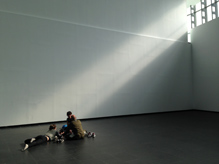
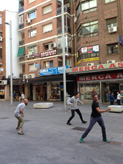
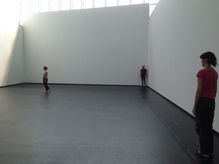
INTÉRPRETES
Joaquín Abella, Pablo Durango, Amalia Fernández, David Herraez, Inma Marín, Lara Ortiz, Patricia Roldán Y Tania Arias Winogradow.
UNE RETROSPECTIVE D’EXPOSITIONS FERMEES / A RETROSPECTIVE OF CLOSED EXHIBITIONS, Kunsthalle Fribourg, 05.08 - 19.11.2016
Une Rétrospective d’expositions fermées / A Retrospective of Closed Exhibitions
05.08 - 19.11.2016
Du 6 août au 19 novembre 2016 Fri Art propose une rétrospective radicale composée de onze fermetures de l’espace du Centre d’art– à la suite les unes des autres – par onze artistes différents. Le 19 novembre, une grande fête se tiendra dans l’espace réouvert de Fri Art et un important catalogue anthologique de 600 pages sur l’Anti-Musée sera publié pour l’occasion.
Lefevre Jean Claude – 19.08.2016
Swetlana Heger & Plamen Dejanov 20.08.2016 – 26.08.2016
Santiago Sierra 30.08.2016 – 05.09.2016
Graciela Carnevale 08.09.2016 – 14.09.2016
Rirkrit Tiravanija 17.09.2016 – 23.09.2016
Robert Barry 26.09.2016 – 02.10.2016
Matsuzawa Yutaka 05.10.2016 – 11.10.2016
Maria Eichhorn 14.10.2016 – 20.10.2016
Maurizio Cattelan 22.10.2016 - 28.10.2016
Daniel Buren 02.11.2016 – 08.11.2016
Hi Red Center 13.11.2016 – 19.11.2016
Ouverture 19.11.2016 + Party
Une exposition de : Mathieu Copeland
La Rétrospective d’expositions fermées a débuté le 6 août dernier, au début de la pause estivale officielle de Fri Art avec l’exposition de Lefevre Jean Claude. Jusqu’au 19 novembre, onze expositions engendrant chacune une manière différente de fermer l’espace d’exposition se succèdent à un rythme quasi hebdomadaire pour former Une Rétrospective d’expositions fermées. Depuis le début des années 1960, des artistes ont pris le parti radical de fermer des musées ou des galeries pour faire œuvre. Ces gestes historiques sont réactivés spécialement pour le contexte de Fri Art en étroite collaboration avec les artistes ou leurs héritiers. Ces œuvres sans compromis nous confrontent à la fermeture de l’espace et nous invitent à expérimenter leur réalité physique, sensible, ou encore conceptuelle. Se déployant dans le temps, sur le mode d’une répétition quasi beckettienne d’un motif récurrent, mais selon des modes d’action très divers, ce projet se veut expérimental dans sa manière d’aborder le genre de la rétrospective. L’exposition explore les extrêmes limites du champ de l’art et défie les attentes des visiteurs en mettant en jeu des questions autant esthétiques que politiques. Si des termes comme « anti-lieu », « anti-art », « anti-galerie commerciale » sont souvent utilisé par les artistes des années 1960, les gestes de fermeture des quinze dernières années sont accompagnés de questionnements sur le travail, le temps et le système économique de l’art.
Ces gestes ne signent pas une négation totale de l’art. Comme l’histoire nous l’a apprise, les tabula rasa indiquent toujours un renouvellement. Des artistes comme Daniel Buren ou Maurizio Cattelan (dont les expositions fermées constituaient leur toute première exposition personnelle) ont développé par la suite de longues carrières très productives. Une installation de Buren occupe actuellement la totalité du toit de verre de la Fondation Louis Vuitton à Paris, tandis que Cattelan participe à la Biennale Manifesta de Zurich après avoir bénéficié d’une rétrospective tonitruante au Guggenheim Museum de New York (2011).
Les onze expositions fermées
Lefevre Jean Claude présentait une réplique de son œuvre de 1981, qui consistait à profiter de la fermeture estivale de la galerie Yvon Lambert à Paris pour énoncer une exposition qui n’existait que par le texte apposé aux vitrines, une œuvre performative, au sens linguistique du terme, qui annonçait simplement « une exposition de lefevre jean claude 11.07/31.08 ‘81 ». (Jusqu’au 19 août 2016)
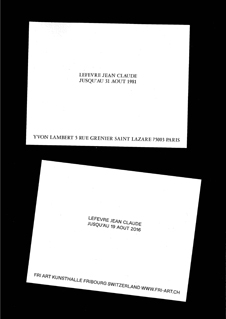
Swetlana Heger & Plamen Dejanov, un duo d’artistes aujourd’hui séparé, développent une réflexion sur les conditions économiques de l’art. En février 1999, ils envoyaient le personnel de la galerie berlinoise Mehdi Chouakri en vacances et fermaient de fait l’espace. La pancarte originale de l’exposition annonçant la fermeture pour vacances de la galerie berlinoise est installée sur la porte du rez de Fri Art et en interdit l’accès. (20 au 26 août 2016)
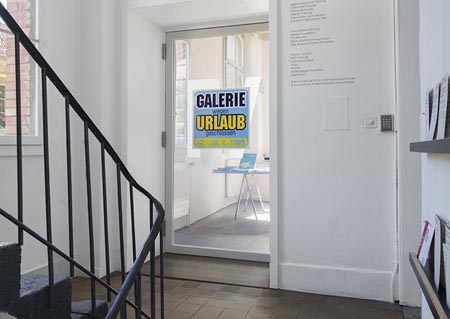
En écho à la crise financière qui ébranlait l’Argentine en 2002, Santiago Sierra avait bloqué avec le même acier ondulé utilisé par les banques pour se protéger de leurs clients un autre type d’institution financière : la Lisson Gallery de Londres. (du 30 août au 5 septembre 2016)
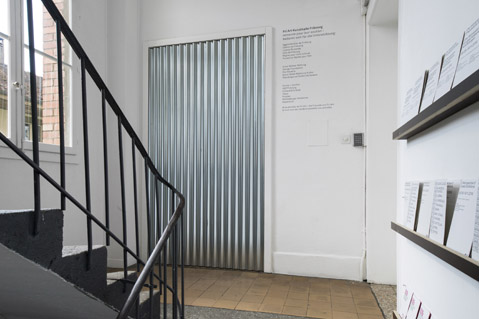
Pour l’exposition qu’elle présentait en octobre dans le cadre de l’Experimental Art Series qu’elle co-organisait durant l’année 1968 à Rosario en Argentine, Graciela Carnevale enfermait à son insu le public dans la galerie, faisant ainsi écho au régime dictatorial et répressif militaire. Au bout de quatre heures, un passant avait fini par briser la vitre, libérant les spectateurs. (du 8 au 14 septembre 2016)
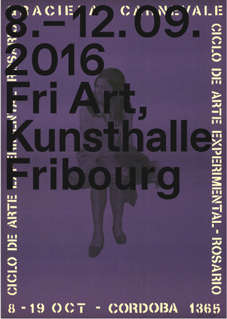
Rirkrit Tiravanija, invité en 2007 à inaugurer l’espace d’exposition de l’Ontario College of Art and Design à Toronto, bloquait l’entrée avec des parpaings sur lesquels il reprenait le slogan situationniste : « Ne travaillez jamais ». (du 17 au 23 septembre 2016)
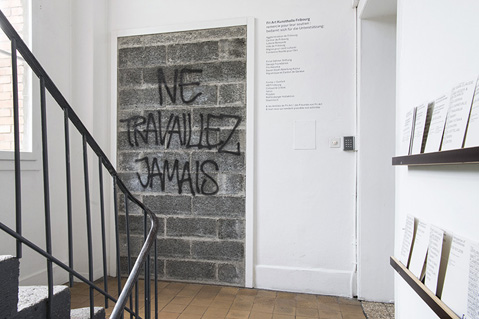
Robert Barry annonçait en 1969 que durant l’exposition, les galeries Eugenia Butler, Art & Project et Sperone seraient fermées. L’artiste manifestait ainsi une velléité critique contre le marché de l’art, se posant volontairement comme « anti-galerie ». (du 26 septembre au 2 octobre 2016)
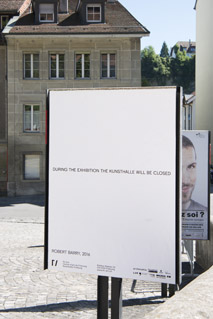
En octobre 1964, à la galerie Naiqua, Matsuzawa Yutaka, avec « Ah, Nil, Ah, A Ceremony of Psi’s Secret Embodiment Drowning in the Wilderness: Prototype Exhibition », affirmait par sa fermeture la galerie comme « anti-lieu ». (du 5 au 11 octobre 2016)
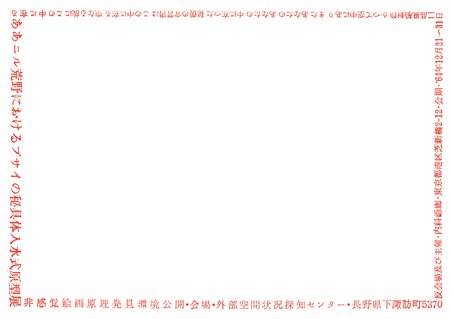
Au printemps de cette année, Maria Eichhorn demandait à l’ensemble des employés de la Chisenhale Gallery à Londres de soustraire leur travail de l’institution, et ainsi fermait par nécessité le centre d’art pour cinq semaines, soit 25 jours ou 175 heures de travail non acquittées. (du 14 au 20 octobre 2016)
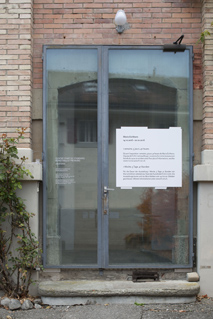
Maurizio Cattelan, l’artiste italien bien connu du grand public pour ses sculptures provocatrices citant le Pape ou Hitler, fermait en 1989 la galerie Néon à Bologne pour sa première exposition personnelle, ne laissant visible qu’un écriteau annonçant « torno subito », soit « je reviens tout de suite ». (du 22 au 28 octobre 2016)
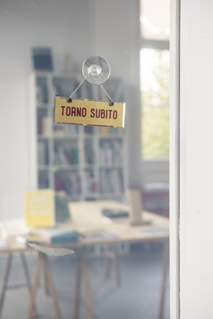
Également pour sa première exposition personnelle à la galerie Apollinaire de Milan fin octobre 1968, Daniel Buren présentait un travail consistant à fermer la galerie le temps de l’exposition en recouvrant totalement la porte d’entrée avec des papiers peints rayés blanc et vert. Par ce geste, l’artiste indiquait son refus de la galerie, et d’une partie de ses fonctions. (du 2 au 8 novembre 2016)
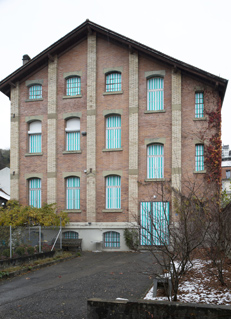
En mai 1964, au travers de Great Panorama Exhibition, le collectif japonais Hi Red Center fermait la galerie Naiqua de Tokyo. Comme le rappelait Akasegawa Genpei, « ce grand panorama mettait l’univers en boîte ». (du 13 au 19 novembre 2016)
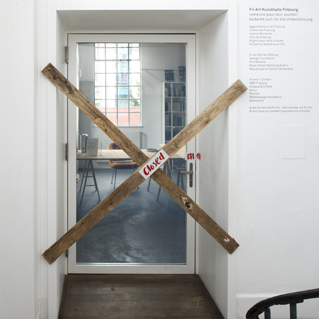
--
A Retrospective of Closed Exhibitions
From 6 August to 19 November 2016, Fri Art proposes a radical retrospective consisting of eleven closures of the art centre space – one following the other – by eleven different artists. On 19 November, a large celebration will mark the re-opening of Fri Art space, along with the release of a major anthological publication entitled “The Anti-Museum”.
Lefevre Jean Claude – 19.08.2016
Swetlana Heger & Plamen Dejanov 20.08.2016 – 26.08.2016
Santiago Sierra 30.08.2016 – 05.09.2016
Graciela Carnevale 08.09.2016 – 14.09.2016
Rirkrit Tiravanija 17.09.2016 – 23.09.2016
Robert Barry 26.09.2016 – 02.10.2016
Matsuzawa Yutaka 05.10.2016 – 11.10.2016
Maria Eichhorn 14.10.2016 – 20.10.2016
Maurizio Cattelan 22.10.2016 - 28.10.2016
Daniel Buren 02.11.2016 – 08.11.2016
Hi Red Center 13.11.2016 – 19.11.2016
Opening 19.11.2016 + Party
An exhibition by Mathieu Copeland
The “Retrospective of Closed Exhibitions” began on 6 August, the beginning of Fri Art’s official summer break, with Lefevre Jean Claude’s exhibition. Until 19 November, eleven exhibitions closing the art centre will follow one another on an almost weekly basis, thus forming the retrospective. Since the early 1960s, artists have seized the pattern of closing to create works. These historic gestures are reactivated especially for Fri Art, in close collaboration with the artists or their estate. These uncompromising works confront us with the closed space, and invite us to experience their physical, sensory and conceptual reality. Over the course of three months, in an almost Beckettian repetitive mode of a recurrent pattern, but according to highly diverse modes of action, the project approaches the retrospective genre in an experimental way. The exhibition explores the extreme limits of the field of art and defies visitors’ expectations by bringing into play questions as aesthetic as they are political.
Lefevre Jean Claude presents a replica of his 1981 work, which took advantage of the summer closing of the Yvon Lambert gallery in Paris to set out an exhibition that existed only in the text affixed to the gallery windows. A performative work, in the linguistic understanding of the term, which simply announced ‘an exhibition by lefevre jean claude 11.07/31.08 ‘81’. (Until 19 August 2016)
Swetlana Heger & Plamen Dejanov, developed a collaborative practice at the turn of the 2000’s , that offered among others a consideration on the economic conditions of art. In February 1999, they sent Mehdi Chouakri gallery’ staff on holiday, thus closing the space. The original sign for the exhibition announcing the Berlin gallery’s holiday closing is re-installed at Fri Art, closing the space. (From 20 to 26 August 2016)
Echoing the financial crisis that shook Argentina in 2002, Santiago Sierra blocked also in 2002, with the same corrugated iron used by Argentinean banks to protect themselves from their clients, access to another type of financial institution: the Lisson Gallery in London. (From 30 August to 5 September 2016)
For her exhibition presented in October 1968 as part of the Experimental Art Cycle in Rosario, Argentina, Graciela Carnevale locked the visitors inside the gallery without them knowing, thereby mirroring the country’s dictatorial and repressive military regime. After four hours, a passer-by released the spectators in smashing the window. (From 8 to 14 September 2016)
Rirkrit Tiravanija, invited in 2007 to inaugurate Toronto’s OCAD exhibition space, blocked the entrance with cinder-blocks on which he reprised the Situationist slogan ‘Ne Travaillez Jamais (Never Work).’ (From 17 to 23 September 2016)
Robert Barry announced in 1969 that during the exhibition, the Art & Projec, Sperone and Eugenia Butler galleries would be closed. The artist manifested an attack on the gallery system, deliberately presenting himself as ‘anti-gallery’. (From 26 September to 02 October 2016)
In October 1964, at the Naiqua Gallery in Tokyo, with “Ah, Nil, Ah, A Ceremony of Psi’s Secret Embodiment Drowning in the Wilderness: Prototype Exhibition”, Matsuzawa Yutaka affirmed the gallery as an “anti-venue” by closing it. (From 5 to 11 October 2016)
In spring this year, Maria Eichhorn requested that all the entire staff of the Chisenhale Gallery in London withdraw their labour for five weeks, thereby obligatorily closing the art centre for the duration of the 5 weeks, 25 days, 175 hours exhibition by necessity. (From 14 to 20 October 2016)
Maurizio Cattelan, the Italian artist well known for his provocative sculptures depicting the Pope or Hitler, closed the Galleria Neon in Bologna in 1989 for his first solo exhibition, leaving only a sign announcing ‘torno subito’ (‘I’ll be back soon’) visible. (From 22 to 28 October 2016)
For his first solo exhibition at the Apollinaire Gallery in Milan at the end of October 1968, Daniel Buren presented a work that entailed closing the gallery for the exhibition duration by entirely covering over the entrance door with white and green striped wallpaper. With this gesture, the artist created a dialogue between his refusal of the traditional use of the walls and his acceptance of the gallery and some of its purposes. (From 2 to 8 November 2016)
In May 1964, through the “Great Panorama Exhibition”, the experimental art Japanese collective the Hi Red Center closed the Naiqua Gallery in Tokyo. As Akasegawa Genpei noted ‘this great panorama canned up the universe’. (From 13 to 19 November 2016)
THE EXHIBITION OF A FILM / L'EXPOSITION D'UN FILM
with / avec Mac Adams, Fia Backström, Robert Barry, Erica Baum, Stuart Brisley, Jonathan Burrows, Nick Cave, David Cunningham, Philippe Decrauzat, Peter Downsbrough, Maria Eichhorn, F.M. Einheit, Tim Etchells, Alexandre Estrela, John Giorno, Sam Gleaves, Kenneth Goldsmith, Myriam Gourfink, Karl Holmqvist, Marie-Caroline Hominal, Myriam Lefkowitz, Franck Leibovici, Benoît Maire, Charles De Meaux, Karen Mirza & Brad Butler, Ieva Misevičiūtė, Meredith Monk, Charlotte Moth, Phill Niblock, Deborah Pearson, Vanessa Place, Michael Portnoy, Lee Ranaldo, Lætitia Sadier, Laurent Schmid, Leah Singer, Mieko Shiomi, Susan Stenger, Sofia Diaz + Vítor Roriz, Kasper T. Toeplitz, Daniel Turner, Cosey Fanni Tutti, Alan Vega, Lawrence Weiner
An exhibition by / Une exposition de Mathieu Copeland
the exhibition of a film
Taking its construct both within the reality of a film and its medium, The exhibition of a film envisages through a polyphony of sound and images the possible textures offered by the cinematic environment. The time of the film stems from the spatial ad-equation of a projected image and of a sound heard. The film’s spatialization defines its different textures, and thus creates an exhibition both to be seen and listened to, in other words, an experience in cinema. An exhibition for a context, namely a film screened in a cinema, and thus as much an exhibited film, the film of an exhibition or again a filmed exhibition.
Working within its own abstraction, this exhibition as a feature film plays with the spatialization of sound, and its polyphony in space. It envisages the unicity of the image and its possible fragmentation on the screen. This exhibition considers its structure as its material, and is constructed by the alternating and confronting of abstract elements and/or filmed scenes.
The exhibition of a film aims at being something other than a structuralist ‘epic’, or a suite of artist’s short films one after the other. Instead, each layer is constitutive of the whole, becoming a potential field of action.
l’exposition d’un film
Partant autant de la réalité du film que des médiums qui la compose, l’exposition d’un film envisage au travers d’une polyphonie sonore et visuelle l’ensemble des textures possibles dans l’espace du cinéma. Le temps d’un film est ici envisagé par la disposition spatiale d’une image projetée et d’un son écoutée. La spatialisation d’un film en définit les strates, et crée ainsi une exposition à être vue et entendue – en sommes une expérience de cinéma. Une exposition pour un contexte, soit un film projeté en salle de cinéma. Il s’agit autant d’un film exposé, du film d’une exposition et d’une exposition filmée.
Travaillant sa propre abstraction, ce film articule la spatialisation du son et sa polyphonie dans l’espace, l’unicité de l’image et sa division à l’écran. Cette exposition considère sa structure comme son matériau, et se rythme par l’alternance et la confrontation de motifs abstraits et/ou de scènes filmées.
L’exposition d’un film ne se pense pas comme un ‘épique’ film structurel et structuraliste, et se situe à l’opposé d’une suite de séquences s’ajoutant les unes aux autres. Discrépant, chaque strate constitutive de l’ensemble devient un champ d’action possible.
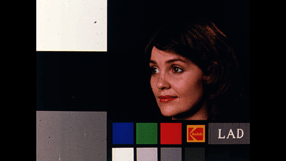
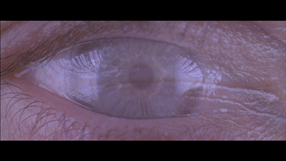
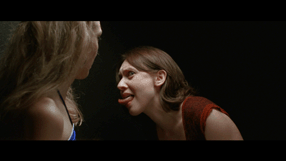
DCP Interop 2K flat 24p
Audio 5.1 (48kHz / 24 bits)
VO-ANG / No subtitles
Duration: 100 minutes
An exhibition by / Une exposition de
Mathieu Copeland
Dramaturg/Dramaturge
Tim Etchells
Original scores enacted by/Partitions originales interprétées par
Nada Gambier, Wendy Houstoun and/et Jerry Killick
With/avec Lucy McCormick and/et Jennifer Pick
Under the direction of/Sous la direction de
Tim Etchells and/et Mathieu Copeland
Editor/Chef Monteuse
Pascale Alibert
Sound Design & Mix
Philippe Ciompi
Director of Photography/Directeur de la Photographie
Tom Wright
Focus Puller/1er assistant caméraman
Chris Connatty
2nd Assistant Cameraman/2ème assistant caméraman
David Geli
Sound Recording/Preneur de son
Jack Sandham
Light Technician/Technicien lumière
Ben Moon
Hair and Make up Artist/Maquilleuse et coiffeuse
Paula Recabarren
Runner/Assistant de plateau
Daniel Montanarini
Filmed on location at the Institute of Contemporary Arts, London (ICA)/Film tourné à l’Institut d’Art Contemporain de Londres (ICA)
Graphic Design/Charte graphique
Nicolas Eigenheer & Jeremy Schorderet
A Production Of / Une Production
Head – Genève
With The Support Of The / Avec Le Soutien
Du Fonds Strategique De La Hes-So
A PERSONAL SONIC GEOLOGY
13.05–26.07.15
Vernissage mardi 12.05, 18h-21h
Avec Boyle Family, une carte mentale, la chute d’eau, un désert, FM Einheit, une exposition, un événement, la fabrique de peinture, Ellen Fullman, Gilles Furtwängler, une grotte, Marcia Hafif, Peter Halley, Fritz Hauser, l’imprimerie, Tom Johnson, Ulrich Krieger, Alan Licht, Lydia Lunch, John M Armleder, Agathe Max, Gustav Metzger, l’usine de tissage.
Une exposition de Philippe Decrauzat et Mathieu Copeland
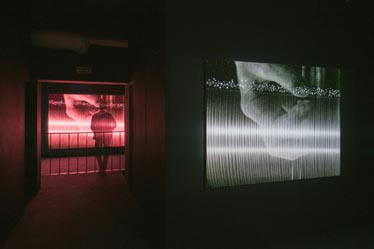
A Personal Sonic Geology regroupe l’ensemble des films coréalisés par Mathieu Copeland et Philippe Decrauzat depuis 2012. Nés du désir de filmer le son, d’enregistrer des lieux et de plonger dans la matière des processus de fabrication et de destruction, ces films sont présentés selon un mode de projection intégrant l’exposition de peintures écrans monochromes.
Invités à réaliser une programmation d’événements et d’expositions au plateau depuis mars 2014, Mathieu Copeland et Philippe Decrauzat ont à chaque fois utilisé ces espaces et ce temps pour faire intervenir des artistes du champ plastique ou musical – à travers le format de l’exposition ou celui, plus dense, de l’événement – et les filmer, avec comme finalité de poursuivre leur collaboration filmique pour donner à voir et à entendre sous la forme d’un dispositif immersif, ce qui aura déjà été vu, entendu et vécu.
Instaurant ainsi un dialogue entre image filmique, peinture et production sonore, les films, réalisés en relation avec une constellation d’artistes, mettent en oeuvre les procédés de surimpression et de fragmentation de l’image au moyen de la pellicule 16 mm. Qu’il s’agisse de filmer des musiciens, tels Alan Licht, Ellen Fullman ou FM Einheit alors qu’ils réalisent la bande-son des films à venir, d’instaurer un dialogue oeuvre-caméra avec les dessins de Marcia Hafif ou avec un tableau de Peter Halley, de filmer des moments ou des lieux de création – la réalisation d’une peinture de John M Armleder, la recréation d’une action/démonstration de Gustav Metzger ou la grotte de l’artiste et « chercheuse » suisse Emma Kunz – ou encore des lieux de production comme une imprimerie à Marrakech, une usine de filature textile ou une fabrique de peintures, les composantes de ces films forment ici un assemblage linéaire de réalités superposées.
Ce programme a fait l’objet d’une série de manifestes rédigés par des artistes invités, conférant à chaque manifestation – exposition ou événement – son titre et reliant ainsi tous les éléments du projet, tels des maillons d’un même vaste ensemble nous proposant une relecture d’une histoire de la modernité par le biais des arts visuels et de la musique.
* Manifeste de Susan Stenger
rendez-vous
Live Evil
13.06.15 – 19h
Live de Max Turner (Agathe Max et Gareth Turner)
Violon et contrebasse amplifiés
Max Turner, égrégore et voyageur spatio-temporel, navigue entre Lyon et Bristol avec pour seul bagage sa contrebasse et son violon électriques. Le drone qu’il diffuse en souffle continu se répand dans les éléments et les êtres afin de faire apparaître en chacun des forces telluriques, des fleuves de métal fondu comme autant de veines incandescentes. Les cordes amplifiées ouvrent une faille dans laquelle les coeurs se lovent, surpris par la paradoxale force fragile qui s’en dégage. La magie de l’électricité agît sur la contrebasse et sur le violon, instruments ancestraux et pourtant rendus ainsi si contemporains. Max Turner aime le débat et ne rentre en aucun cas dans des conventions figées, des théories absurdes sur ce que devrait être ou ce qu’est la musique ou XXIème siècle, puisque, chercheur, il ne cesse d’expérimenter et dans son laboratoire de sons, une fine distillation s’opère, révélant plus qu’un élixir une expérience sonique unique.
Visite commissaires avec Mathieu Copeland et Philippe Decrauzat
Dimanche 28 juin – 17h30
Conversations de plateau
Mercredi 8.07.15 – 19h30
Des invités interviennent sur les questions du son, du cinéma et du manifeste, autant de maillons constituant l’exposition. Ils échangent et livrent leurs regards sur celle-ci.
Avec Nicolas Couturier (graphiste, collectif g.u.i.), Maxime Guitton (programmateur et commissaire d’exposition) et Jonathan Pouthier (programmateur cinéma).
--
A PERSONAL SONIC GEOLOGY
13.05–26.07.15
With Boyle Family, a mental map, a waterfall, a desert, FM Einheit, an exhibition, an event, a factory paint, Ellen Fullman, Gilles Furtwängler, a cave, Marcia Hafif, Peter Halley, Fritz Hauser, a printery, Tom Johnson, Ulrich Krieger, Alan Licht, Lydia Lunch, John M Armleder, Agathe Max, Gustav Metzger, a spinning mill.
An exhibition by Philippe Decrauzat and Mathieu Copeland
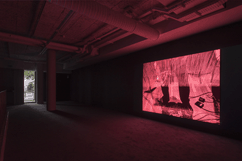
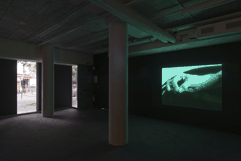
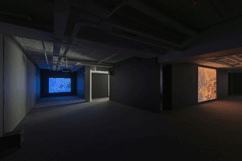
A Personal Sonic Geology gathers together the films realised by Mathieu Copeland and Philippe Decrauzat since 2012. Stemming from a desire to film sound, record places, and dive into the process of a material construction and destruction, these films are screened using a projection apparatus that integrates an exhibition of monochrome screens/paintings.
Invited to create a programme and events and exhibitions at le Plateau from march 2014 on, Mathieu Copeland and Philippe Decrauzat have each time used these spaces and this time to involve artists from the visual and music fields—using the exhibition format, or he denser format of the event—and film, their end purpose being to pursue their film collaboration to present to the eye and ear, in the form of an immersive arrangement, something that has already been seen, heard and experienced.
Creating a dialogue between filmed images, painting and
sound production, these films bring together a constellation of artists, superimposing and fragmentating the 16 mm film stock. Filming musicians including Alan Licht, Ellen Fullman or FM Einheit as they realise the soundtrack for these films to be, creating a dialogue between works of art and the camera, with Marcia Hafif’s drawings or a painting by Peter Halley, filming moments and places of creation such as the realisation of a painting by John M Armleder, the re-enactment of a lecture-demonstration by Gustav Metzger, Swiss artist and “researcher” Emma Kunz’s Grotto, and production sites including a printing press in Marrakech, a textile manufacture or a paint factory, the film’s components shape a linear assemblage of overlaid realities.
This programme has been the subject of a series of manifestos drawn up guests artists, lending each exhibition and event its title and thus connecting all the elements of the project, like links in one and the same huge enselmbe, offering us a re-reading of a history of modernity seen through visual arts and music.
*Susan Stenger manifesto.
WAYWORDS OF SEEING
12.06–27.07.14
Vernissage mercredi 11.06, 18h-21h
Avec Francis Baudevin, Boyle Family, David Cunningham, FM Einheit, Morgan Fisher, Marcia Hafif, David Hominal, Steven Parrino, Stephen Partridge, Martin Rev, Karin Sander, Amikam Toren, Dan Walsh
Une exposition organisée par Philippe Decrauzat et Mathieu Copeland
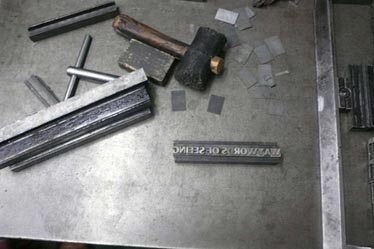
Empruntant son nom à un titre manifeste de Dan Walsh, l’exposition Waywords of Seeing envisage le point de vue, le regard, le champ et le hors-champ au travers du prisme de la dérive des mots**.
S’y déploient des trajectoires aux arborescences multiples : cartographier et exposer un réel fragmenté au hasard, penser des transcriptions visuelles d’univers sonores et électriques, proposer une archéologie d’images et de situations reconstituées et transformées.
L’exposition Waywords of Seeing dessine des espaces en négatif qui se découvrent à travers des « véhicules » réalisés par Dan Walsh pour chaque espace et offre une investigation du champ de la perception, en explorant la distance entre l’œuvre et celui qui la regarde, comme autant de points de vue de et sur l’exposition.
Une mise en abîme de la vision par une démultiplication d’expériences, replaçant le corps dans sa relation à l’image à un niveau scientifique, psychologique et narratif.
Waywords of Seeing interroge et conditionne le regard via une succession de filtres, dessinant ainsi des expositions dans l’exposition.
* *Le titre du manifeste de Dan Walsh intègre un jeu de mots – voire un jeu de lettres – en partant de « waywards » qui signifie « errance, dérive, égarement ».
--
WAYWORDS OF SEEING
12.06–27.07.14
Opening Wednesday 11 June, from 6 to 9 pm
With Francis Baudevin, Boyle Family, David Cunningham, FM Einheit, Morgan Fisher, Marcia Hafif, David Hominal, Steven Parrino, Stephen Partridge, Martin Rev, Karin Sander, Amikam Toren, Dan Walsh
An exhibition curated by Philippe Decrauzat and Mathieu Copeland.
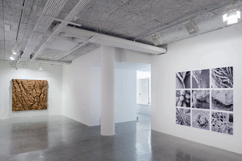
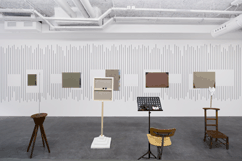
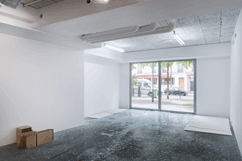
Taking its name from a title-statement by Dan Walsh, Waywords of Seeing considers the viewer’s gaze – in and out of the field of perception – through a prism of drifting words: the random mapping of places, the visual transcription of a sonic and electric realm, the archaeology of images and circumstances which have been reconstituted and transformed.
Waywords of Seeing creates negative space to be discovered through the “vehicles” conceived by Dan Walsh: they offer an investigation of the field of perception through the exploration of the distance separating the work of art and the viewer – creating in the process a multitude of points of view of and about the exhibition.
A multiplication of vision through different experiences repositions the body in relation to its image on scientific, psychological and narrative levels. Waywords of Seeing both questions and conditions the gaze via a succession of filters, ultimately forming exhibitions within the exhibition.
Une exposition – un événement
Suite pour exposition(s) et publication(s),
quatrième mouvement.
Avec Mac Adams, Art & Language, Fia Backström, Robert Barry, Julien Bismuth, Claude Closky, Peter Downsbrough, Liam Gillick, Pratchaya Phinthong, Georgia Sagri, Betty Tompkins, Oriol Vilanova, Cally Spooner, et une publication de Genesis Breyer P Orridge.
Une exposition de Mathieu Copeland
Du 15 octobre 2013 au 26 janvier 2014
Dans le cadre de la programmation Satellite, "Suite pour exposition(s) et publication(s)" s’offre, en quatre mouvements, comme une réflexion sur l’exposition, son image, sa représentation ainsi que son catalogue. Sous le titre "Une exposition – des projections", le quatrième mouvement interroge l’exposition à travers la notion de projection, entendue ici dans une large acception – orale, mentale, cinématographique –, qu’il s’agisse de la projection du mot par la lecture du catalogue d’une exposition passée (entresol et niveau –1) ou de la projection du texte avec un film à être lu (auditorium).
Une reprise
Reprise / re-pri-z’ / n. & v. : n. 1. Passage répété dans un morceau de musique. 2. Article repris dans un programme musical. v. tr. répétition (performance, chanson, etc.) ; nouvelle présentation (théâtre, film), réécriture. [Français, fém. participe passé de reprendre]
Une exposition, une fois qu’elle a achevé son cours, se cristallise dans les productions qu’elle a engendrées, dans le souvenir de ceux qui en ont fait l’expérience, mais aussi dans son catalogue, qui met généralement à disposition le détail des travaux qu’elle a présentés. Le catalogue d’une exposition "reproduit" les images des objets qui ont contribué à la faire exister et / ou des vues de celle-ci. Ainsi, il en est, au mieux, la mémoire ; au pire, il n’en est que la check-list.
Cette "reprise" de l’exposition "Art & Language", qui s’est tenue au Jeu de Paume du 9 novembre 1993 au 2 janvier 1994, s’offre comme le désir de revisiter la mémoire de cet événement autant que de lui conférer une nouvelle réalité. Sans qu’aucune œuvre ne soit montrée, la manifestation passée est envisagée de nouveau à travers la lecture de son catalogue, utilisé comme une partition. Diffusé dans les salles, l’enregistrement sonore (exécuté par Jonathan Reig) de l’ensemble de l’ouvrage – lu en français par Olivier Claverie et en anglais par Kate Lith – permet une compréhension nouvelle de cette exposition et de son rapport au texte. Cependant, il ne restitue qu’un écho lointain de l’original, affirmant l’exposition comme un matériau en continuelle expansion qui, en tant que tel, peut être repris des semaines, des mois ou des années plus tard, et dans des contextes différents. Au travers de cette (re)lecture "projetée", qui constitue un nouvel événement en soi, le catalogue devient ainsi le libretto d’une exposition en constant devenir.
En parallèle, la publication du recueil de poèmes intitulé Life as a Cheap Suitcase, carte blanche offerte à Genesis Breyer P-Orridge, figure pionnière de la musique industrielle, dépasse la conception du catalogue comme simple représentation de l’exposition par le livre. Parce qu’il donne le sentiment de l’exposition, cet ouvrage, somme toute, en est le miroir et la continuité.
Un film à être lu
Dans l’auditorium, est projetée de manière continue une exposition du mot à travers un "film à être lu", constitué d’un enchaînement de textes d’artistes écrits spécifiquement pour ce dernier.
La description du sentiment d’une oeuvre par Robert Barry, un script de mots de femmes par Betty Tompkins, un secret partagé de Pratchaya Phinthong, un film noir de Mac Adams, une phrase en attente de Liam Gillick, une prédiction du temps par Oriol Vilanova, une poésie informatique abstraite de Claude Closky, un voyage mental avec Georgia Sagri, l’utilisation du texte par Julien Bismuth dans le but de faire "apparaître" des images, une polyphonie de Cally Spooner ou, encore, la transformation de la salle noire du cinéma en un théâtre intérieur par Fia Backström – toutes ces œuvres sont articulées entre elles par des transitions réalisées par Peter Downsbrough. Unifiés par la typographie, les textes forment autant les sous-titres d’un film sans images que des projections mentales qui se construisent dans l’esprit de celui qui les lit.
--
Exhibitions—A Projection
Suite for Exhibition(s) and Publication(s),
fourth movement.
With Mac Adams, Art & Language, Fia Backström, Robert Barry, Julien Bismuth, Claude Closky, Peter Downsbrough, Liam Gillick, Pratchaya Phinthong, Georgia Sagri, Betty Tompkins, Oriol Vilanova, Cally Spooner, and a publication by Genesis Breyer P Orridge.
An exhibition by Mathieu Copeland
from 15 october 2013 until 26 january 2014
For the sixth edition of its Satellite programme, the Jeu de Paume has invited curator Mathieu Copeland. Conceived as part of the “Suite for Exhibition(s) and Publication(s),” “An exhibition – An Event” will be presented at the Jeu de Paume from 28 May to 1 September 2013. It will echo the two movements “A Spoken Word Exhibition” and “An Exhibition Without Texts,” which were presented respectively at the Jeu de Paume and the Maison d’Art Bernard Anthonioz. This exhibition examines the moment when the image becomes an abstraction of itself until it disappears in favor of the event. The event should be envisaged in its widest sense: a musical score of an event, a suggested reading, or an action that takes place in the ancillary spaces allocated to the Satellite program. Mathieu Copeland’s proposal explores what happens in neutral contexts and how a formal presence is activated in them.
A Reprise
Reprise /ri’pri:z/ n. & v. : n. 1. A repeated passage in music. 2. A repeated item in a musical programme. v. tr. repeat (a performance, song, etc.); restage, rewrite. [French, fem. past part. of reprendre]
An exhibition, once it has run its course, crystallizes into the products that it generated, in the recollection of those who experienced it, and also in its catalogue, which generally provides details about the works on display. The exhibition catalogue “reproduces” images of the objects that contributed to its existence and/or views of it. It is thus, at best, a memory of it; at worst, it is nothing more than a checklist of it.
This “reprise” of the “Art & Language” exhibition, which took place at the Jeu de Paume between November 9, 1993 and January 2, 1994, reflects as much a desire to revisit the memory of this event as a desire to give it a new reality. Without any works even being shown, the past event is envisaged anew through a reading of its catalogue, which is used as a score. Broadcast in the rooms, the sound recording (engineered by Jonathan Reig) of the entire book—read in French by Olivier Claverie and in English by Kate Lith—permits a new understanding of this exhibition and its relation to the text. However, it restores only a distant echo of the original, affirming the exhibition as constantly expanding material which, as such, can be reprised weeks, months or even years later, in various contexts. Through this “projected” (re)reading, which constitutes a new event in itself, the catalogue thus becomes the libretto of an exhibition that is constantly in becoming.
In parallel, the publication of the collection of poems Life as a Cheap Suitcase, for which Genesis Breyer P-Orridge, a pioneer of industrial music, was given carte blanche, goes beyond the concept of the catalogue as a representation of the exhibition in book form. This publication, to the extent that it conveys the feeling of it, is ultimately both a mirror and a continuation of the exhibition.
A Film to Be Read
In the auditorium, an exhibition of the words is projected continuously in the form of a “film to be read,” consisting of a succession of artists’ texts written specifically for it.
The description of the feeling of a work by Robert Barry, a script of women’s words by Betty Tompkins, a shared secret by Pratchaya Phinthong, a film noir by Mac Adams, a suspended sentence by Liam Gillick, a prediction of time by Oriol Vilanova, an abstract computer poem by Claude Closky, a mental journey with Georgia Sagri, the use of text by Julien Bismuth to make images “appear,” a polyphony by Cally Spooner and the transformation of the dark room of the cinema into an internal theatre by Fia Backström— all these works are intertwined in a string of words created by Peter Downsbrough. Unified by their typography, the texts are both the subtitles of a film without images and mental projections constructed in the mind of the person reading them.
Mandala Mental
Con Luigi Amara, Philippe Decrauzat, Myriam Gourfink, y con la participación de F.M. Einheit, Ulrich Krieger, Alan Licht, Gustav Metzger, Robert Poss y Alan Vega.
Un exposición de Mathieu Copeland
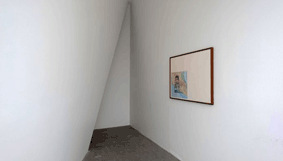
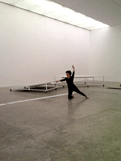
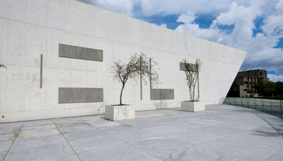
La exposición Mandala Mental, proyecto realizado por Mathieu Copeland, parte de la concepción de que las exhibiciones suceden sobre todo en la mente. Mediante una práctica de curaduría experimental, Copeland busca ahondar acerca de la relación entre las obras de arte y la experiencia del espectador.
Mandala Mental articula tres elementos. Por un lado, una película es proyectada sobre pinturas negras de gran formato realizadas por el artista suizo Philippe Decrauzat. El film retrata a músicos (F.M. Einheit, Ulrich Krieger, Alan Licht, Alan Vega y Robert Poss) produciendo la banda sonora, intercalados con paisajes y acercamientos a cuadros de nylon rociados con ácido siguiendo las instrucciones del artista austriaco Gustav Metzger.
Ese montaje en vivo contrasta con la simplicidad de la acción de una coreografía de Myriam Gourfink, ejecutada por Margot Dorléans, que inscribe una línea imaginaria en el espacio. Su partitura es al mismo tiempo las instrucciones para una bailarina, el libreto para el público y la memoria de aquello que está por suceder.
Finalmente, acompaña a la muestra el texto de una exposición imaginaria concebida por el escritor Luigi Amara. Queriendo cuestionar el rol de las exhibiciones y obras de arte, Mathieu Copeland aspira a que esos elementos construyan una exposición como una situación que sólo es posible en tanto alguien, un sujeto, la complete con su presencia.
--
A Mental Mandala
With Luigi Amara, Philippe Decrauzat, Myriam Gourfink, and featuring F.M. Einheit, Ulrich Krieger, Alan Licht, Gustav Metzger, Robert Poss and Alan Vega.
An Exhibition by Mathieu Copeland
A Mental Mandala comprises three main elements – an exhibition of paintings and projected films & music, a choreography that defines through time space itself, and a text that contextualise a dramaturgy for yet another possible exhibition.
An exhibition of raw, white and blacks paintings taking the shape of a film-still gradually fragmented are disseminated throughout the galleries. Inside the gallery, the black monochromes act in turn and alternatively as the screens for the projected films as an exhibition realised together with Swiss artist Philippe Decrauzat. This series focuses on filming a musician as he produces the soundtrack for this film to be. Portraits of musicians F.M. Einheit, Ulrich Krieger, Alan Licht, and Alan Vega are superimposed with a landscape that encompasses views of a textile factory, dunes of the Sahara desert or extreme close up of a nylon canvas smeared with acid as instructed by Gustav Metzger.
In the other gallery, the presence of the body through time unveils a slow inscription in space as a dancer works an imaginary line. A score written by French choreographer Myriam Gourfink for one dancer, Margot Dorléans, choreograph a walk whose duration is that of an exhibition. Ultimately, this score is both the instructions for the dancer, the libretto for the public, the memory of what had happen, and for what is about it to happen.
The sensitive articulation in time and space of the exhibition ultimately takes the form of a text. This writing act as a dramaturgy to what is present, taking an exhibition and the presentation of artefacts as the means to generate a new narrative, reframing what is to be seen in the mind of the one who reads. A possible comprehension of the mandala – the ephemeral, and the mind – the immaterial, offers the sensitive mental experience of an exhibition that looks at one. A Mental Mandala is a choreographed exhibition whose sole reality exists within the minds of the ones who complements it all.
Une exposition – un événement
Suite pour exposition(s) et publication(s),
troisième mouvement.
Avec Mieko Shiomi, Maria Eichhorn et Tim Etchells, et une publication de Douglas Coupland.
Une exposition de Mathieu Copeland
Du 28 Mai au 01 Septembre 2013
.gif)
.gif)
.gif)
Dans le cadre de la programmation Satellite, « Suite pour exposition(s) et publication(s) » s’offre, en quatre mouvements, comme une réflexion sur l’exposition, son image, sa représentation ainsi que son catalogue. Sous le titre « Une exposition – un événement », le troisième mouvement envisage ce moment où l’œuvre fait abstraction d’elle-même pour se jouer du spectacle de l’exposition, que ce soit au travers d’actions morcelées dans l’espace et dans le temps, d’invitations à imaginer un événement par le texte ou encore d’interventions et gestes infimes, réalisés notamment au sein d’espaces interstitiels. L’événement, considéré ici dans son acception la plus large et selon une approche fragmentaire et déceptive, consacre ainsi le non-événement.
Entre 1965 et 1975, l’artiste Fluxus Mieko Shiomi (née en 1938, vivant à Osaka) orchestre une suite de neuf Spatial Poems (« Poèmes spatiaux ») articulés autour de micro-actions effectuées parallèlement, aux quatre coins du globe, par différents performers, jouant de la fragmentation de l’événement en différents lieux et instants. L’invitation adressée aux participants fonctionne comme la partition de l’événement par le biais d’instructions elles que rapporter la direction de ses déplacements à un moment déterminé ou enregistrer la chute provoquée d’un objet. Les comptes rendus établis par Shiomi exploitent autant le texte pour son caractère narratif que pour ses effets graphiques et spatiaux : Spatial Poem No. 2: A Fluxatlas (1966) recense et commente, sur une carte géographique, la position de chacun des intervenants à une heure donnée ; Spatial Poem No.3: A Fluxcalender (1968) constitue un calendrier de toutes les performances menées sur la durée de l’événement. Dans le même registre que les poèmes spatiaux, Events & Games (1965) contient une série de cartes appelant à réaliser des interventions subtiles et minimales dans l’environnement (par exemple, tourner en rythme autour d’une flaque d’eau tout en la regardant). La lecture de ces invitations aujourd’hui s’offre en écho à ces actions passées, dans un dialogue sans cesse renouvelé.
À l’occasion de l’exposition, le dramaturge et chorégraphe britannique Tim Etchells (né en 1962, vivant à Sheffield), cofondateur du collectif Forced Entertainment, interroge la manière dont la lecture peut générer un événement. Invitations à susciter des performances par le seul biais du texte, ses Fight Posters (« Affiches de combats », 2012) annoncent une série absurde de combats imaginaires, soulignant conflits sociaux et politiques non résolus ou rivalités médiatiques stéréotypées. Live Forever (« Vivre pour toujours », 2013), sculpture de glaçons formée des onze lettres de son propre titre, explore la relation entre le texte comme espace sémiotique et objet matériel : ce qui est énoncé en toutes lettres ne peut se réaliser, la fonte des mots s’opérant progressivement au fil des jours. Le dessin mural Let Go (« Lâcher prise », 2013) répète trois mots simples sous la forme d’une séquence évolutive et changeante de plusieurs lignes, comme si leur auteur s’exerçait à faire une déclaration. La dernière ligne, LET IT GO, vient démentir le travail accumulatif demandé par l’énonciation textuelle de l’œuvre. Let Go explore les aspects contradictoires du langage : la vitesse, la clarté et la vivacité avec lesquelles celui-ci transmet un récit, une image et des idées et, en même temps, sa propension à créer confusion, incertitude et tension.
Maria Eichhorn (née en 1962, vivant à Berlin) se saisit de l’institution comme d’un médium en tant que tel, s’immisçant dans ses interstices, contournant ses contraintes administratives et budgétaires pour sonder, altérer et subvertir sa logique et son mode de fonctionnement. Ici, elle met à mal le statut événementiel de l’exposition par le biais de deux nouvelles pièces susceptibles de demeurer invisibles. Peinture de l’adresse du Jeu de Paume, en blanc sur blanc et en léger relief, sur un pan de mur du hall d’entrée, 1 place de la Concorde, 75008 Paris (2013) est à peine perceptible, exigeant une certaine proximité pour devenir lisible. Avec Entrée gratuite (2013), l’artiste utilise les fonds de production qui lui sont alloués par l’institution pour programmer la distribution sporadique et aléatoire d’un nombre restreint de billets offrant au public la gratuité à l’ensemble des manifestations en cours. Ainsi, Eichhorn souligne la fragilité du moment où l’événement a lieu pour questionner la visibilité même de l’œuvre et, par là même, de l’exposition.
À travers le prisme de l’exposition comme événement s’offrent à la fois une compréhension, une critique et une célébration de l’institution. Etsi le format d’une exposition peut être envisagé en termes de temps et d’espace, il s’agit toujours d’un matériau à construire et à fragmenter.
--
An Exhibition – An Event
Suite for exhibition(s) and publication(s),
third movement.
With Mieko Shiomi, Maria Eichhorn and Tim Etchells, And a publication by Douglas Coupland.
An exhibition by Mathieu Copeland
From the 28th of May to the 1st of September 2013
Part of the Satellite programme, “Suite for Exhibition(s) and Publication(s)” is a reflection, in four movements, on the exhibition, its image and its representation, as well as its catalogue. Titled “An exhibition – An Event”, the third movement examines the moment when the artwork becomes an abstraction of itself, playing on the exhibition as spectacle, be it through actions that are scattered in space and time, invitations to imagine an event in text or through minute interventions and actions carried out in the interstitial spaces of the museum. The event, considered here in its widest sense and using a fragmentary, deceptive approach, thus celebrates the non-event.
Between 1965 and 1975, Fluxus artist Mieko Shiomi (born in 1938, lives in Osaka) orchestrated a series of nine Spatial Poems revolving around micro actions carried out in parallel, around the world, by different performers, playing on the fragmentation of the event into different places and instants. The invitation issued to participants functioned like the score of the event by means of instructions, such as reporting the direction of one’s movements at a specific moment or recording a falling object. The records kept by Shiomi use the text as much for its narrative capacity, as for as its graphic and spatial effects: Spatial Poem No. 2: A Fluxatlas (1966) located and commented on the positions of all the participants at a specific time on a map; Spatial Poem No. 3: A Fluxcalender (1968) featured a calendar of all the performances carried out during the event. In a similar vein to the spatial poems, Events & Games (1965) contained a series of cards with instructions for carrying out subtle, minimal actions in the environment (for example, moving rhythmically around a puddle while looking at it). Reading these invitations today provides an echo of these past actions, generating a dialogue that is continuously renewed.
For this exhibition, British artist and choreographer Tim Etchells (born in 1962, lives in Sheffield), co-founder of the Forced Entertainment collective, examines the way in which reading can generate an event. The Fight Posters (2012), invitations to performances through text alone, announce an absurd series of imaginary fights that underscore unresolved conflicts in the social and political sphere or replay stereotypical media rivalries. Live Forever (2013), an ice sculpture made up of the eleven letters of its own title, explores the relationship between the text as semiotic space and material object: what is announced cannot take place, with the words gradually melting each day. The wall drawing Let Go (2013) repeats three simple words in the form of a developing and mutating sequence over a number of lines, as if their author might be practising a phrase or an utterance. The last line, LET IT GO, refutes the cumulative work demanded by the enunciation in the work’s text. Let Go explores the contradictory aspects of language: the speed, clarity and vividness with which it communicates narrative, image and ideas, and, at the same time, its propensity for creating confusion, uncertainty and tension.
Maria Eichhorn (born in 1962, lives in Berlin) uses the institution itself as a medium, occupying its interstitial spaces, circumventing its administrative and budgetary constraints in order to probe, alter and subvert its logic and its way of operating. Here Eichhorn calls into question the exhibition’s status as event through two new pieces that are likely to remain invisible. 1 place de la Concorde, 75008 Paris (2013), a painting of the address of the Jeu de Paume, in white on white and in low relief, on one of the walls in the entrance hall, is barely perceptible and is readable only close up. In Entrée gratuite (2013), the artist uses the production budget allocated to her by the institution to arrange for the sporadic, random distribution of a limited number of tickets offering free admission to all the events taking place at the time. Eichhorn thereby emphasises the fragility of the moment when the event takes place in order to question our very perception of the artwork and, in turn, the exhibition itself.
Through the prism of the exhibition as event, an understanding, a critique and a celebration of the institution emerge. And although an exhibition’s format can be envisaged in terms of time and space, it remains a material to construct and fragment.
An Exhibition Happening Everywhere, At All Times, with Everyone
A Lecture by Mathieu Copeland
Wednesday, April 17, 2013, 6:00 p.m.
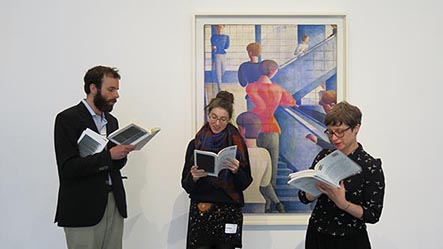
Theater 3 (The Celeste Bartos Theater), mezzanine, The Lewis B. and Dorothy Cullman Education and Research Building
Artists Experiment is a new initiative in the Department of Education that brings together contemporary artists in dialogue with MoMA educators to conceptualize ideas for developing innovative and experimental public interactions.
Curator Mathieu Copeland discusses the poetics of interstitial, neutral and otherwise overlooked off-spaces—and off-times—of museums and galleries. He envisages how they can be activated and seen anew through a variety of perspectives, and thus subvert the traditional role of exhibitions and renew the way they are perceived.
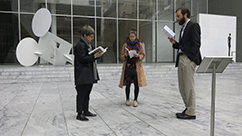

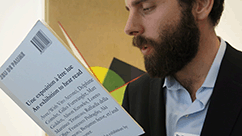
An Exhibition to Hear Read
On April 17, 18 and 19, look out for an exhibition of the words in the interstitial spaces of the museum, an art whose cohesion is not so much spatial, but mental, as Textual artworks written by Vito Acconci, Robert Barry, Delphine Coindet, Keren Cytter, Gilles Furtwängler, Nicolas Garait, Goldin + Senneby, Kenneth Goldsmith, Karl Holmqvist, Bethan Huws, Alison Knowles, Benoît Maire, Loreto Martínez Troncoso, David Medalla, Charlotte Moth, Raffaella della Olga, Francesco Pedraglio, Falke Pisano, Aki Sasamoto, Yann Sérandour, Benjamin Seror, Cally Spooner, Irena Tomažin, and Sue Tompkins, are read from the series of Exhibitions to Hear Read curated by Mathieu Copeland by three readers (Ceel Mogami de Haas, Anne Hildbrand and Daphné Roulin, from the Geneva University of Art and Design HEAD—Genève).
Activating the "non-spaces," and offering to Museum visitors the opportunity to experience artworks through the voice, an exhibition to hear read proposes the notion of speech as material gesture, in which both the texture of the word and its spoken quality are inscribed in space and time through the act of reading. The vocal interpretation of these artworks constructs an abstract and ephemeral reality that can be said to sculpt the spaces in which it occurs. This ongoing investigation into the materiality of artwork as a question of word and speech is crystallized through a series of publications that act as both score and memory.
April 17, 5–6 p.m.: Cullman mezzanine, 4 W. 54 Street
April 18, 3–5 p.m.: Bauhaus Lounge, third floor and MoMA Sculpture Garden
April 19, 12:30–1:30 p.m. and 3–4 p.m.: Bauhaus Lounge, third floor and MoMA Sculpture Garden
UNE EXPOSITION SANS TEXTES, Maison d'Art Bernard Anthonioz, Nogent sur Marne - FR, 21/03 - 19/05/2013
Une exposition sans textes
Suite pour exposition(s) et publication(s),
deuxième mouvement.
Satellite 6.
Avec Vito Acconci, Francis Baudevin, Stefan Brüggemann, Delphine Coindet, Gilles Furtwängler, Matt Golden, Idris Khan, Alison Knowles, Loreto Martínez Troncoso, Raffaella della Olga, Francesco Pedraglio, Giandomenico Tonatiuh Pellizzi, Claude Rutault, Aki Sasamoto, Benjamin Seror, Cally Spooner, Amikam Toren, Jacques Villeglé, Gil Joseph Wolman… Et une publication de franck leibovici.
Une exposition de Mathieu Copeland.
Maison d’Art Bernard Anthonioz, Nogent-sur-Marne
du 21 mars au 19 mai 2013
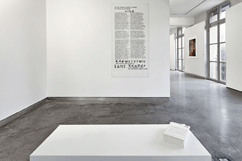
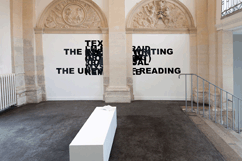
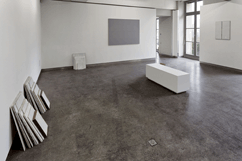
Deuxième mouvement de la suite pour exposition(s) et publication(s) proposée par Mathieu Copeland, « Une exposition sans textes» s’offre en écho direct et simultané a « Une exposition parlée », premier mouvement présente au Jeu de Paume à Paris. Si cette dernière questionne la place du mot et de la lecture dans l’exposition, ce deuxième mouvement en prend le contrepoint pour aborder ce moment où le texte fait image, ou l’écriture (dans sa plus large acception) s’efface, générant ainsi une image abstraite et affirmant la disparition du sens au profit d’une autre lecture.
Une exposition n’est pas l’illustration d’un texte. Tout comme les œuvres qui la compose et sans lesquelles elle ne pourrait être, elle n’appelle pas un paratexte ni ne découle d’un format impose. Sa forme n’est pas prédéfinie en fonction d’une mise en espace pour un temps donne.
Envisageant la superposition et l’accumulation au travers d’œuvres de Stefan Bruggemann, Matt Golden et Idris Khan, l’effacement, la déchirure et une cryptographie du réel, mises en jeu par Jacques Villegle, la re-peinture et l’obstruction chez Francis Baudevin, Giandomenico Tonatiuh Pellizzi, Claude Rutault ou encore l’oblitération et la défiguration avec Amikam Toren et Gil Joseph Wolman, « Une expositions sans textes» s’articule autour de la volonté affirmée d’annuler tout texte ou toute image. Cette approche de l’exposition dans ce qu’elle peut avoir de plus formel insiste sur l’existence de l’œuvre à travers la représentation que l’on s’en fait ou et les mots que l’on projette.
--
An Exhibition Without Texts
Suite for Exhibition(s) and Publication(s),
second movement.
With Vito Acconci, Francis Baudevin, Stefan Brüggemann, Delphine Coindet, Gilles Furtwängler, Matt Golden, Idris Khan, Alison Knowles, Loreto Martínez Troncoso, Raffaella della Olga, Francesco Pedraglio, Giandomenico Tonatiuh Pellizzi, Claude Rutault, Aki Sasamoto, Benjamin Seror, Cally Spooner, Amikam Toren, Jacques Villeglé, Gil Joseph Wolman… And a publication by franck leibovici.
The second movement of the “Suite for Exhibition(s) and Publication(s)” by Mathieu Copeland, “An Exhibition Without Texts” is a direct, simultaneous echo of the first movement, “A Spoken Word Exhibition,” presented at the Jeu de Paume. Whereas the latter questioned the role of words and reading in the exhibition, the second movement provides a counterpoint by addressing the moment when the text becomes image, when writing (in its widest sense) disappears, thereby generating an abstract image and affirming the disappearance of meaning in favour of a different reading.
An exhibition is not the illustration of a text. Like the works that compose it and without which it could not exist, it does not call on a paratext and it does not derive from an imposed format. Its form is neither predetermined nor dictated by a presentational text and by its creation in space at a given time.
Une exposition parlée
Suite pour exposition(s) et publication(s),
premier mouvement.
Satellite 6.
Avec Vito Acconci, Delphine Coindet, Yona Friedman, Gilles Furtwängler, Matt Golden, Kenneth Goldsmith, Idris Khan, Alison Knowles, Loreto Martínez Troncoso, David Medalla, Gustav Metzger, Raffaella della Olga, Francesco Pedraglio, Aki Sasamoto, Benjamin Seror, Cally Spooner... et une publication de Kenneth Goldsmith.
Une exposition de Mathieu Copeland
du 26 février au 12 mai 2013



La première exposition conçue par Mathieu Copeland dans le cadre de la programmation Satellite du Jeu de Paume envisage l’exposition du mot et la diffusion d’une œuvre dans sa globalité par l’oral. Entre écriture et image mentale, lecture et écoute, celle-ci interroge l’unicité de la lecture et de la parole, la place du mot dans l’exposition, la question de l’exposition et du catalogue – ou plutôt de l’exposition du catalogue…
Le texte – lu – permet son interprétation, et en devient ainsi autant sa partition que sa mémoire. "Une exposition à être lue" génère des figures à être dites, l’abstraction du langage permettant à une forme d’être et, naturellement, une fois dite, de se dissoudre. Parallèlement à cette exposition par le livre est présentée une série de "rétrospectives parlées". Gustav Metzger, qui fait de la destruction et de l’impermanence des motifs de son œuvre, David Medalla, au travers de l’éphémère et de l’impromptu, et d’autres sont invités à enregistrer par leur voix une rétrospective idéale de leur œuvre, soit leurs vies. Un engagement dont le motif et la matérialité ne peuvent exister — survivre — que par l’exposition non documentaire d’une œuvre radicale et qui échappe autant que possible à la présentation de la rétrospective classique. Chaque rétrospective n’existe qu’au travers des mots dits par les artistes — par la mémoire de ceux qui ont créé —, générant ainsi l’image mentale d’une exposition du temps (temps d’une œuvre dont la disparition affirme son existence, temps d’une vie passée) dans l’esprit de ceux qui écoutent.
--
A Spoken Word Exhibition
Suite for Exhibition(s) and Publication(s),
first movement.
With Vito Acconci, Delphine Coindet, Yona Friedman, Gilles Furtwängler, Matt Golden, Kenneth Goldsmith, Idris Khan, Alison Knowles, Loreto Martínez Troncoso, David Medalla, Gustav Metzger, Raffaella della Olga, Francesco Pedraglio, Aki Sasamoto, Benjamin Seror, Cally Spooner... and a publication by Kenneth Goldsmith.
An exhibition by Mathieu Copeland.
from 26 February 2013 until 12 May 2013
The first exhibition conceived by Mathieu Copeland as part of the Jeu de Paume’s Satellite program envisages the exhibition of the word and the diffusion of an entire work orally.
Combining writing and mental image, reading and listening, it questions the uniqueness of reading and speech, the place of the word in the exhibition, the question of the exhibition and the catalogue – or rather of the exhibition of the catalogue...
The – read – text makes possible its interpretation, thus becoming its score as well as its memory. “An Exhibition to Hear Read” generates figures to be said, the abstraction of language enabling a form to come into being and, naturally, once uttered, to dissolve. In parallel with this exhibition through the book a series of “spoken retrospectives” is presented. Gustav Metzger, who uses destruction and impermanence as motifs in his work, David Medalla, through the ephemeral and the impromptu, and others are invited to record with their voices an ideal retrospective of their work, or their lives. The motive and materiality of this undertaking can only exist – survive – through the non-documentary exhibition of a radical work, one that avoids as far as is possible the classic presentation of the retrospective. Each retrospective exists only through the words spoken by artists – through the memory of those who have created – thus generating the mental image of an exhibition of time (time of a work whose disappearance affirms its existence, time of a past life) in the minds of those who are listening.
SUPPORTIVE, 1966 - 2011 - auto-creative art by Gustav Metzger
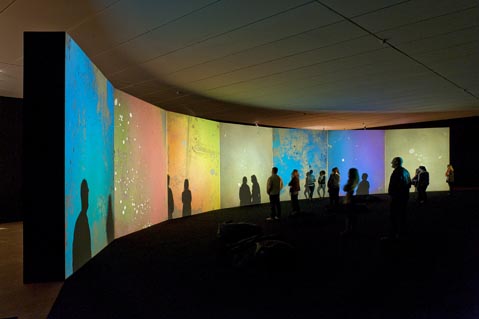
une exposition de Mathieu Copeland au Musée d'art contemporain de Lyon
14.02.2013 – 14.04.2013
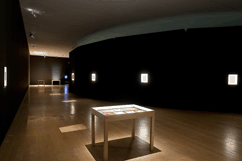
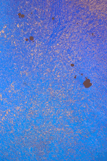
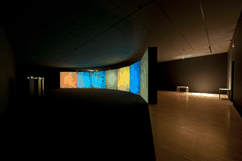
L’art auto-créatif est indissolublement lié à ce qui fut son corollaire, l’art auto-destructif, que Gustav Metzger définit dès novembre 1959 dans son premier manifeste auto-publié. Si son œuvre est souvent envisagé à travers le prisme prépondérant de l'auto-destruction, il nous apparaît aujourd’hui nécessaire de considérer l’envers de toute destruction : l’auto-création.
Metzger associe dès ses débuts le développement d'une pensée théorique et philosophique radicale à une expérimentation artistique constante. Ce sont ces deux dimensions que l'exposition met en œuvre. S'y trouvent réunis pour la première fois, les cinq manifestes « historiques » publiés par l'artiste entre 1959 et 1964, ainsi qu’un ensemble de documents reflétant sa pensée et son engagement pour un art auto-créatif. Gustav Metzger le définit ainsi en 1962 : « Avec cette forme d’art comme avec l’art auto-destructif, le temps, l’espace, le mouvement, la métamorphose et le son jouent un rôle à la fois différent et beaucoup plus important dans la conception, la construction et l’appréciation de l’œuvre […] ». Ces documents inédits sont présentés avec Supportive, 1966-2011, une œuvre récemment acquise par le Musée. Cet environnement monumental fait de cristaux liquides incarne l’auto-création, principe élaboré dès 1959, dans sa plus vaste mise en œuvre réalisée à ce jour.
--
Auto-creative art is inseparably linked to its corollary, auto-destructive art, which Gustav Metzger defined in November 1959 in his first self-published manifesto. His work is mainly considered through the prism of auto-destruction, yet it appears as necessary to now envisage the opposite of destruction, auto-creation.
From the very beginning, Metzger combined the development of theoretical thought and radical philosophy with constant artistic experiment. These two dimensions are the core of the exhibition, which, for the first time, brings together the five “historic” manifestoes published by the artist between 1959 and 1964, as well as a set of documents reflecting his ideas and his commitment to auto-creative art, which he described as follows in 1962: “In this art form, as in Auto-Destructive Art, time, space, motion, metamorphosis and sound have a different far more important role in the conception, construction and appreciation of the work […].” Never previously exhibited, these documents are presented alongside Supportive, 1966-2011, a work recently acquired by the Museum. This monumental environment made of liquid crystals is the embodiment of auto-creation, as it was elaborated by Metzger from 1959 onwards. It is the most immersive implementation of these principles to date.
NOTHIN' BUT WORKING - Phill Niblock, une retrospective ; Circuit & Musee de l'Elysee de Lausanne - CH, 30/01 - 12/05 2013
NOTHIN' BUT WORKING - Phill Niblock, une retrospective
30.01.2013 – 14.05.2013
Nothin’ but Working
Phill Niblock, une rétrospective
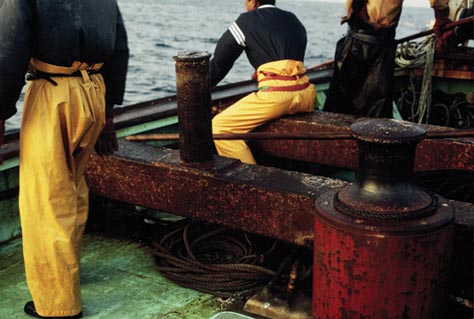
une exposition de Mathieu Copeland présentée conjointement à Circuit, centre d’art contemporain et au Musée de l’Elysée
Né en 1933, Phill Niblock propose depuis plus de 50 ans au travers d’un « Art Intermedia » une oeuvre pluridisciplinaire. Associant musique minimaliste, art conceptuel, cinéma structurel, art systématique ou encore politique, Niblock s’active à transformer notre perception et notre expérience du temps.
Sur une proposition de Circuit, les photographies, films, installations et l’intégralité de sa musique enregistrée sont réunis au sein de cette première exposition rétrospective consacrée à l’entier de l’oeuvre de Phill Niblock. Cette exposition de Mathieu Copeland est présentée conjointement à Circuit, centre d’art contemporain et au Musée de l’Elysée à Lausanne.
Reconnu comme l’un des grands compositeurs expérimentaux de notre époque, Phill Niblock débute sa carrière artistique comme photographe. Originaire d’Indianapolis, passionné de jazz, il s’installe à New York en 1958. Niblock débute la photographie en 1960 et pendant quatre ans se spécialise dans les portraits des musiciens de jazz tels que Charles Mingus, Billy Strayhorn et Duke Ellington, qu’il accompagne fréquemment en enregistrement et en concert. Au milieu des années 1960, il passe de la photographie au film et, au contact de la chorégraphe et fondatrice d’Experimental Intermedia, Elaine Summers, devient caméraman pour les danseurs et chorégraphes du Judson Church Theater, dont Yvonne Rainer et Meredith Monk. À partir de 1968, Niblock se consacre à la musique et compose ses premières pièces qui doivent — comme le précise l’artiste — être écoutées à fort volume pour en explorer les surharmoniques (overtones).
Depuis le milieu des années 1960, son oeuvre photographique réalisée en argentique dépeint l’architecture et l’urbanisme new-yorkais. La séquence et l’agencement des vues proposent
une cartographie du lieu et de l’objet photographiés, tels que les édifices abandonnés de Welfare Island (aujourd’hui Roosevelet Island) en 1966, le quartier désaffecté au sud du Bronx en 1979 ou les façades du district de SoHo Broadway en 1988. A partir de 1966, Niblock s’engage dans une réflexion sur la production d’images en mouvement au travers de séries de films et suites de diapositives. Produit entre 1966 et 1969, Six Films, une suite de courts métrages sonores réalisés en 16 mm, annonce sa démarche expérimentale au travers de portraits d’artistes et musiciens, dont Sun Ra et Max Neuhaus.
Dès 1968, l’artiste expérimente l’association de ses productions visuelles à son oeuvre musicale pour créer des compositions architecturales et environnementales. La série des Environments, recréée au Musée de l’Elysée par l’artiste pour la première fois depuis sa dernière présentation en 1972, extrait, par l’image, la réalité de plusieurs environnements, tout en créant un environnement temporaire dense et intense d’images projetées, de musique et de mouvements dans l’espace du musée.
L’exposition à Circuit
Présentée pour la première fois dans son intégralité, rééditée et remasterisée par l’artiste pour la rétrospective, la série de films The Movement of People Working (Le mouvement des gens
qui travaillent) dépeint le travail humain dans sa forme la plus élémentaire. Filmé entre 1973 et 1991 en 16 mm couleur, puis en vidéo, dans des lieux comme le Pérou, le Mexique, la Hongrie, Hong-Kong, l’Arctique, le Brésil, le Lesotho, le Portugal, Sumatra, la Chine et le Japon — avec plus de 25 heures de film en tout, The Movement of People Working se concentre sur le travail pris comme une chorégraphie de mouvements et de gestes, sublimant la répétition mécanique et pourtant naturelle des actions des travailleurs. Phill Niblock explique avoir commencé The Movement of People Working « par nécessité, car ma musique s’accompagnait de danse simultanée, et c’était trop laborieux et trop onéreux de tourner avec tout ce monde. Alors j’ai fait ces films, que je pouvais projeter pendant que je jouais. »
Les films sont accompagnés par la collection de lentes compositions musicales évolutives de Niblock, à l’harmonie si minimaliste, composées entre 1968 et 2012. Le volume sonore utilisé lors de la diffusion de ces longs drones en offre une expérience viscérale, et vient animer les harmoniques toutes scintillantes, palpitantes. Ses partitions, présentées dans l’exposition sous forme de photostats réalisés pour son exposition personnelle à l’ICA de Londres en 1982, sont les instructions de mixage du compositeur – celles-ci ne sont pas utilisées par le musicien lors de la performance, il joue avec les enregistrements, se déplaçant dans l’espace, en créant parfois des correspondances de tonalités sur l’enregistrement ou alors en créant des dissonances. Il en résulte un mouvement constant de rythme/pulsation battement, et des harmoniques changeantes en continu lors de ses déplacements dans l’espace. La superposition des tons vient faire écho à la répétitivité de l’activité des ouvriers ; sur chaque écran, la succession des films (qui changent tout au long de la journée), combinée avec un programme aléatoire qui choisit au hasard différentes compositions musicales, résultent en un renouveau permanent des formes, proposant sans cesse de nouvelles juxtapositions de son et d’images.
The Movement of People Working tient un propos fort, politique et social, que le titre met bien en évidence et qui se manifeste par la proximité avec les travailleurs. En cela, cette série de films peut faire écho au travail de certains cinéastes comme Jean-Luc Godard et Chris Marker qui, dès 1967, donnèrent la caméra aux ouvriers en leur expliquant les rudiments techniques du cinéma afin qu’ils puissent réaliser leurs propres films. Dans un fascinant retournement de la situation, plutôt que de faire de la fiction ou du pur documentaire, certains ouvriers formèrent les groupes Medvedkine et décidèrent de se filmer en train de travailler.
-- TEXT IN ENGLISH --
Born in 1933, Phill Niblock has produced, for over more than fifty years, a multidisciplinary work. His “Intermedia Art” features a combination of minimalist music, conceptual art, structural cinema, systematic or even political art, and has actively contributed to transform our perception and experience of time.
Upon a proposal by Circuit, the photographs, films, installations and all his recorded music are brought together for the first time in a retrospective exhibition dedicated to Phill Niblock’s entire artistic endeavour. This exhibition by Mathieu Copeland is presented simultaneously at the Contemporary Art Center Circuit and at the Musée de l’Elysée in Lausanne.
Admittedly one of the greatest experimental composers of our time, Phill Niblock initiated his career as a photographer and film director. Born in Indianapolis, a jazz afficionado, he moved to New York in 1958 where he started photography in 1960, specializing in portraits of jazz musicians such as Charles Mingus, Billy Strayhorn and Duke Ellington, that he frequently accompanies in studio and during concerts. In the middle of the 60s, he shifts from photography to film: encouraged by Elaine Summers, the choreographer and founder of the Experimental Intermedia, he becomes the cameraman for the dancers and choreographers of the Judson Church Theatre, such as Yvonne Rainer and Meredith Monk. From 1968 on, Niblock focused on music and composed his first pieces, which, according to the artist, should be listened to at loud volume in order to explore their overtones.
Since the mid-60s, his analogue photographic work explores New York’s architecture and urban planning. The sequencing and layout of his images offer a mapping of the location and object photographed, such as the abandoned buildings of Welfare Island (today Roosevelt Island) in 1966, the disused district of South Bronx in 1979, or the facades of SoHo Broadway district in 1988. From 1966, Niblock undertakes a thorough consideration on the production of moving images through his series of films and slideshows. Produced between 1966 and 1969, Six Films, a series of short films with sound realized with 16 mm film, heralds his experimental method through portraits of artists and musicians such as Sun Ra and Max Neuhaus.
In 1968, the artist began experimenting a combination of his visual productions with his musical scores in order to create architectural and environmental sound compositions. Recreated by the artist for the first time since its last presentation in 1972 for the retrospective, the Environments series extracts the reality of different surroundings through images, all the while generating a dense and intense temporary environment of projected images, music and movements throughout the museum’s space.
Exhibition at the Contemporary
Art Center Circuit
Presented for the first time in its entirety, re-edited and remastered by the artist for the retrospective, the series of films The Movement of People Working portray human labour in its most elementary form. Filmed on 16mm colour film, and later on video, in locations including Peru, Mexico, Hungary, Hong Kong, the Arctic, Brazil, Lesotho, Portugal, Sumatra, China and Japan – with more than 25 hours of film footage, The Movement of People Working focuses on work as a choreography of movements and gestures, dignifying the mechanical yet natural repetition of labourers’ actions. Phill Niblock said of these that The Movement of People Working «came out of necessity because I was doing music performances with live dancers, and it was too cumbersome and expensive to tour with so many people. So I started doing those films that I could project when performing».
These films are accompanied by the whole corpus of Niblock’s slowly evolving, harmonically minimalist music, realised between 1968 and 2011. The sound level of these compositions offers a visceral experience of the long drones and inhabits the ringing, beating overtones. These scores, presented in the exhibition as photostats realized for his personal exhibition at London’s ICA in 1982, are the composer’s mixing instructions and are not used by the musician during the performance. While moving through space, he plays with the recorded material, sometimes creating tonalities that coincide with the recording or, on the contrary, that produce dissonances. The result is a constant movement of beat, rhythm and pulsation, as well as changing and continuous harmonics during his own motion through space. The layering of tones echoes the repetitions of the workers’ actions; the evolution of the films on each screen (changing throughout the day), combined with a program that randomly plays back different music pieces, results in a constant renewal of forms, continuously offering an exhibition of new juxtapositions of sound and image.
The Movement of People Working offers a strong social and political comment, as highlighted by the title and represented by the closeness with the workers. In this, the series of film echoes the work of several filmmakers including Jean Luc Godard or Chris Marker who as from 1967 gave workers the cameras and informed them of cinematic techniques so that they could actually make their own films. In a fascinating turn of events, rather than doing fictional or pure documentary film, some workers formed the Groupes Medvekine and decided to film themselves working.
50 PARTITIONS
14.12.2012 – 26.01.2013
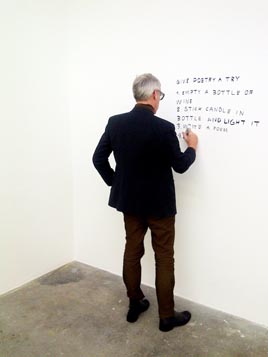
Avec
John M Armleder, George Brecht, John Cage, David Cunningham, Philippe Decrauzat, Jimmie Durham, Robert Fillliou, Henry Flynt, Ken Friedmann, Gilles Furtwängler, Alois Godinat, Jean-Christophe Huguenin, Alison Knowles, Laurent Kropf, George Maciunas, Gustav Metzger, Phill Niblock, Yoko Ono, Mai Thu Perret, Michael Portnoy, Lili Reynaud Dewar, Thomas Schmit, Mieko Shiomi, Ben Vautier, Alan Vega, La Monte Young…
et
Louise Bailat, Thomas Baud, Johana Blanc, Mathias Brugger, Timothee Calame, Martine Gingras, Harold Jefferies, Tayeb Kendouci, Lamya Moussa, Virginie Portier, Magalie Tracqui, Gaia Vincensini, étudiant-e-s à la Head – Genève
Une exposition de Mathieu Copeland et Yann Chateigné
Mise en mots par Karl Holmqvist
Une exposition par le mot, à lire et à interpréter.
Une exposition fragmentée de 50 partitions pour 50 jours par 50 artistes, mais aussi pour 50 ans.
Il est aussi malaisé de cerner avec précision la date de naissance officielle du mouvement Fluxus que de dessiner les contours précis de la constellation d’artistes qui y participe. Par définition, ce groupe d’artistes qui, influencé autant par John Cage, la philosophie orientale que Dada, se rassemble, au début des années 1960, autour des notions de flux et de mouvement, d’interprétation et de circulation.
Aujourd’hui, Fluxus se refuse encore aux cadres établis de l’historiographie y préférant l’intelligence partagée de la création collective et de l’interprétation continue d’un répertoire commun. Prenant comme prétexte la date du «Fluxus-Festspiele Neuester Musik» organisé à Wiesbaden en septembre 1962 par George Maciunas, cette exposition célèbre alors un « non-anniversaire », en posant un regard non pas rétrospectif mais prospectif, sur cette expérience.
Cinquante « partitions » (events, textes, définitions, poèmes, instructions, pièces) sont réunies avec la complicité de John M Armleder, acteur essentiel de la scène genevoise, et dont le groupe ECART, à la fin des années 1960, peut être considéré comme un écho immédiat de Fluxus en Suisse. Durant cinquante jours, celles-ci sont offertes à l’interprétation de cinquante artistes, qu’ils soient liés au groupe ou directement influencés par Fluxus, qu’ils soient des héritiers possibles de cette famille artistique ou dont le travail entre en résonance avec celui des artistes du mouvement, qu’ils soient en formation dans le cadre de l’école.
La forme exposée de ces cinquante partitions est confiée à l’artiste suédois Karl Holmqvist. Le poète et performeur a dessiné une police de caractère basée sur sa propre écriture, mettant ainsi indirectement par écrit ces mots dans l’espace. Sur cette écriture typographiée, il intervient ensuite à la main au travers de notes, textes et dessins, à même les murs de la galerie. Base continue de l’exposition, à partir de laquelle elle s’anime continûment, cette intervention fait écho aux dimensions conceptuelles, performatives, mentales mais aussi musicales, théâtrales, poétiques et vivantes des oeuvres Fluxus. Ce projet active ainsi, en la (re)jouant, une archive potentielle, dont le lieu devient dès lors la chambre d’échos. Cet hommage choral, pris en charge par un réseau d’artistes, accueille en son coeur un groupe d’étudiant-e-s de la Head – Genève, impliqué à divers niveaux du projet: conceptuel, artistique et curatorial. Car ce qui importe ici n’est pas de revivre le passé, mais bien de prolonger cette expérience, voire de la projeter, aujourd’hui, dans le futur.
Vernissage & Performances
Jeudi 13.12.2012 dès 18 h
Rencontre
John M Armleder et Raimundas Malakauskas
Mercredi 19.12.2012 dès 19 h
Suite à un ennui de santé, John Armleder ne sera pas présent pour cette rencontre qui aura tout de même lieu entre Raimundas Malakauskas et Mathieu Copeland et qui sera suivie d’une projection des films ECART, de la collection du FMAC.
Concert
Douze heures de musique en trois actes :
Le répertoire Fluxus et au-delà, interprété et abusé par des artistes aujourd’hui.
Mercredi 16.01.2013 de 12h à 00h
LiveInYourHead, Institut curatorial de la Head – Genève, rue du Beulet 4, 1203 Genève
MARRAKECH PRESS - (les halles) espace d'art contemporain, Porrentruy - CH, 01/12/2012 - 20/01 2013 // Vernissage le Samedi 1er Decembre à Partir de 18h00
MARRAKECH PRESS
Mathieu Copeland & Philippe Decrauzat
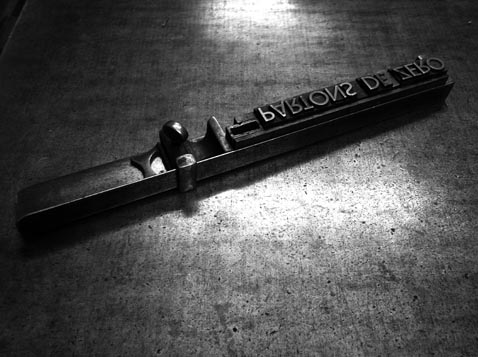
Du 2 décembre au 20 janvier 2013
Vernissage samedi 1er décembre à 18h00
Rencontre avec Mathieu Copeland et Philippe Decrauzat dimanche 2 décembre à 13h30.
Heures d’ouverture :
jeudi : de 17h00 à 19h00
samedi : de 10h00 à 12h00 et de 13h30 à 17h30
dimanche : de 13h30 à 17h30
0u sur rendez-vous 032 420 84 02
Marrakech Press
Marrakech Press est un label de production et d’expérimentation cofondé par le curateur indépendant franco-britannique Mathieu Copeland et l’artiste suisse Philippe Decrauzat. Actif depuis le 1er Janvier 2011, son champ d’action s’étend à l’édition, les expositions, la publication, les manifestes et les films.
L’exposition à l’espace d’art contemporain (les halles), à Porrentruy, s’envisage comme une exposition de peintures, des screenings des deux premiers films produits et réalisés par Marrakech Press, un dessin de Gustav Metzger, et la présentation d’une série de manifestes publiés et distribués à cette occasion.
FILMS
Deux courts-métrages s’articulent et se développent autour du désir de filmer le son et de travailler la superposition et la fragmentation de l’image. Filmés et montés en 16mm, ils suivent à chaque fois la même partition : La surimpression de deux situations dont la première est systématiquement un musicien filmé au moment même où il produit la bande sonore du film. La deuxième, non prédéfinie, est choisie selon les logiques de la dérive et du collage.
Filmé dans le loft new-yorkais du musicien minimaliste Phill Niblock (et enregistré par ce dernier) et à Marrakech dans l’imprimerie régionale, ce premier film rend compte de la surimpression des images du musicien expérimental, le guitariste américain d’avant-garde Alan Licht et des presses de Marrakech, engagées pour l’occasion à faire tourner leur machine, pour ne rien imprimer sur des papiers de format A4 et vierge. Ces mêmes machines ont été utilisées par la suite pour l’impression des manifestes distribués dans l’exposition.
Le second film a été tourné à la frontière Austro-Allemande et dans les montagnes du haut Atlas marocain. Il présente le musicien et percussionniste Allemand F.M Einheit (ex-Einstürzende Neubaten – groupe phare de la musique industrielle post punk créée à Berlin en 1980) au travail chez lui, dans son garage, détruisant briques et miroirs, jouant du son des pierres et du sable sur une large plaque en métal amplifiée. F.M Einheit compose et crée une architecture de ruine abstraite et temporaire, qui se voit superposées à des vues de paysages du Sahara et de l’Atlas.
Ces films sont projetés sur des monochromes noirs de format identique, rythmant l’espace, ces deux peintures-écran s’offrent en écho à un troisième tableau – une composition abstraite de l’artiste Suisse Francis Baudevin repeint en noir pour devenir le tableau test, ici recouvrant sa réalité de ‘peinture’.
MANIFESTES
Bruce McClure, Delphine Coindet, David Cunningham, Peter Downsbrough, Gilles Furtwängler, Kenneth Goldsmith, Lionnel Gras, Scott King, François Kohler, MR Lucy, Gustav Metzger, Raffaella della Olga, Loreto Martinez Troncoso, Diego Santomé, Nick Thurston, et Dan Walsh ont tous été invités à composer et rédiger un manifeste publiés par Marrakech Press, et offert à la lecture dans le cadre de l’exposition.
Tous ces manifestes suivent le même mode de réalisation : Les artistes, curateurs, écrivains, ou encore musiciens ont composé un manifeste, sur le recto d’un format A4. Cette page est ainsi donnée directement aux presses de Marrakech qui les interprète tels une partition et les mettent en page de manière typographique. Ils sont ensuite distribués aux visiteurs de l’exposition.
Finalement, et pour revenir au début, un dessin de Gustav Metzger est présenté dans l’exposition. Réalisé pour la couverture de l’ouvrage ‘Partons de zéro’, première publication de Marrakech Press etprésenté ici en parallèle à son original, ce dessin annonce autant un programme à venir que le contenu d’un livre à considérer comme la partition d’une exposition.
Une édition sera produite dans le cadre de l’exposition.
LE CONFORT MODERNE - Le Confort Moderne, Poitiers, du 16 Mai au 19 Août 2012 // Vernissage le Mercredi 16 Mai à Partir de 18h30
LE CONFORT MODERNE
Une exposition avec Francis Baudevin / Stefan Brüggemann / Henry Codax / Philippe Decrauzat & Alan Licht / Gaylen Gerber / Kenneth Goldsmith / Marc Hurtado & Sébastien Vitré / Martina Klein / Jutta Koether / Sadie Laska / Franck Leibovici / Olivier Mosset / Charlotte Moth / Mai-Thu Perret & Ik ue Mori / Stephen Prina / Florian & Michael Quistrebert / Claude Rutault / Giorgio Sadotti / Hugo Schüwer-Boss / Susan Stenger & F.M. Einheit / Alan Vega / Jacques Villeglé
Commissaire associé : Mathieu Copeland
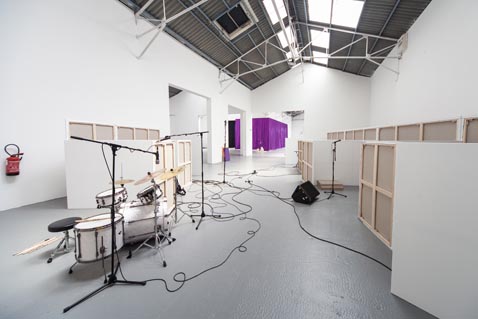
"Le Confort Moderne" au Confort Moderne parle de soi(lui)-même. Une exposition dont l’intitulé porte l’appellation même de l’espace (autant scène musicale mythique que centre d’art contemporain) ne peut que nous ramener à ses enjeux, ces enjeux, nos enjeux!
Mathieu Copeland
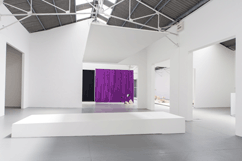
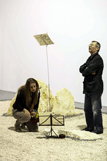
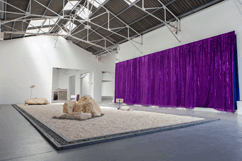
L’exposition est née d’une rencontre avec Mathieu Copeland et la lecture ou plutôt l’écoute commune d’un lieu : Le Confort Moderne. A la fois salle de concerts pionnière et centre d’art depuis plus de vingt ans, le lieu agit comme matrice de l’exposition. L’exposition opère un glissement d’objets picturaux ou conceptuels vers des objets praticables ou réceptacles. L’exposition s’organise en cinq sections : les actions, les partitions, les films, les concerts et la peinture. Les peintures deviennent écran, les concerts activent les oeuvres, les films sont réalisés en collaboration entre artistes et musiciens.
Travaillant une pensée de l’exposition et son rapport entre le "praticable" et "l’objet" (le praxis et l’objekt) – l’oeuvre et l’action de l’oeuvre – "Le Confort Moderne" affirme cette compréhension de l’activation du lieu par les oeuvres, et son corollaire du lieu donnant autant la forme que le contenu. En somme, plus qu’une exposition offrant un confort de l’objet, celle-ci insiste sur le présent de l’action et sa constante modernité.
L’exposition fait dialoguer les oeuvres de près de trente artistes internationaux, de la scène au salon de peinture, de la partition au live, du jardin au cinéma pour la construction d’une oeuvre totale.
--
"Le Confort Moderne" at Le Confort Moderne speaks for itself : an exhibition named after the venue where it takes place (both a mythic music venue and art center) can only bring us back to these issues, its issues, our issues!
Mathieu Copeland
The exhibition arose from a meeting with Mathieu Copeland and from the common feel, or rather the common listening, of the place. Le Confort Moderne has been a music venue and art centre for over 20 years, and its space acts as a matrix of Le Confort Moderne. These modern comforts slides between pictorial or conceptual, through practical objects or receptacles, and is organized into five parts: actions, scores, films, concerts and a painting salon. Paintings become screens, the concerts activate the pieces, the films were made in collaboration between artists and musicians.
Envisaging the exhibition and its link between the 'practicable' and the 'object' (the praxis and the objekt) - the art work and the action of the art work - Le Confort Moderne asserts a reading of a gallery activated by the works within it, while the corollary of the gallery provides the content as much as the form. So to say, more than an exhibition showing comfortable objects, Le Confort Moderne explores the topicality of the action and its continuous modernity. From the stage to the salon de peinture; from the score to the live performance, and from the garden to the cinema, a total work is constructed.
Du 16 mai au 19 août 2012
Entrepôt-galerie du Confort Moderne
Du mercredi au dimanche de 14h00 à 19h00 et les soirs de concerts
Vernissage mercredi 16 mai à partir de 18h30
Performances & Concerts / Susan Stenger & F.M. Einheit / Laetitia Sadier / Rhys Chatham / Nico Vascellari / Martin Rev / James Chance
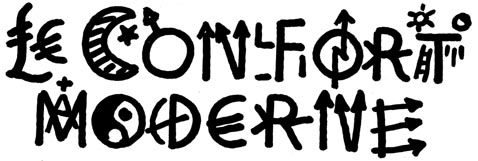
An Exhibition to Hear Read
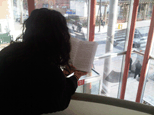
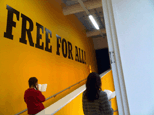
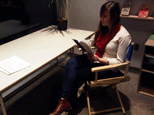
Hear ICA’s interstitial spaces shaped by a polyphony of voices. This spring the Institute of Contemporary Art (ICA) at the University of Pennsylvania will host a unique performative event. Penn students will collaborate with students from HEAD - Geneva to continuously read a selection of textual artworks every day for a week in February.
An exhibition to hear read proposes the notion of speech as material gesture, in which both the texture of the word and its spoken quality are inscribed in space and time through the act of reading. The vocal interpretation of these artworks constructs an abstract and ephemeral reality that can be said to sculpt the spaces in which it occurs. This ongoing investigation into the materiality of artwork as a question of word and speech is crystallized through a series of publications that act as both score and memory.
This event at the ICA will be the fourth in a series of “volumes,” each presented at a different venue. An exhibition to hear read is curated Mathieu Copeland and is realized in partnership with Kenneth Goldsmith, Penn’s Center for Programs in Contemporary Writing, HEAD (Haute école d’art et de design Genève / Geneva University of Art and Design), and the Cultural Services of the French Embassy in the USA. This fourth volume, hosted by the ICA, is the first to be presented in the United States. The first volume was commissioned by the contemporary art center La Synagogue de Delme in France, a second in Geneva by HEAD’s curatorial institute Live In Your Head, and a third by the David Roberts Art Foundation in London.
An exhibition to hear read will be performed by students from the yearlong seminar Writing Through Art and Culture at Penn and from the WORK.MASTER at Geneva University of Art and Design. It features textual works by the following Penn students: Yolanda Carney, Ana Maria Gomez Lopez, Alexander Hovnanian, Staci Kaplan, Ellie Levitt, Christina Lisk, Isabel Oliveres, Sarah Richter, Alexander Schwartz, and Naomi Shavin. It also features written works by artists including: Marí Alessandrini, Robert Barry, Sacha Béraud, Emma Bjornesparr, Jérémy Chevalier, Keren Cytter, Chloé Delarue, Amélie Dubois, Jarrod FowlerNicolas Garait, Goldin + Senneby, Kenneth Goldsmith, Anne-Sylvie Henchoz, Karl Holmqvist, Jean-Christophe Huguenin, Bethan Huws, Livia Johann, Tom Johnson, Franck Leibovici, Benoît Maire, David Medalla, Charlotte Moth, Falke Pisano, Véronique Portal, Lili Reynaud Dewar, Tatiana Rihs, Daphné Roulin, Yann Sérandour, Cally Spooner, Irena Tomažin, Sue Tompkins, Anne Le Troter, and Martina-Sofie Wildberger.
Timed to coincide with Penn’s conference on abstraction (co-sponsored by ICA and the Department of the History of Art), An exhibition to hear read commences on February 10 and runs through February 19.
A Conversation with Mathieu Copeland at the University of Pennsylvania - Kelly Writers House (3805 Locust Walk - Philadelphia, PA 19104) - 02/16/2012 @ 6pm
Mathieu Copeland talks at The Curatorial Hub at ICI (401 Broadway, Suite 1620 ; New York, NY 10013) on February 21st @ 7pm
Reprise #1 - Studies for a catalogue / a study for an exhibition on violence in contemporary art (reprise 1964/2011) - Flat Time House, London - Friday 24 June - Sunday 31 July
Closing Bbq & Publication Launch - Sunday 31 July, 2-6pm
Reprise #1
Studies for a Catalogue: a Study for an Exhibition of Violence in Contemporary Art (Reprise 1964/2011)
with Karel APPEL – Jean ARP – Francis BACON – Enrico BAJ – Elena BAJO – Giacomo BALLA – Davide BALULA – BALTHUS – Erica BAUM – Max BECKMANN – Tom BENSON – Hans BELLMER – George BELLOWS – Emma BJORNESPARR – Peter BLAKE – Umberto BOCCIONI – Frank BOWLING – Georges BRAQUE – Victor BRAUNER – Stefan BRÜGGEMANN – Edward BURRA – Alberto BURRI – Reg BUTLER – Alexander CALDER – Guiseppe CAPOGROSSI – Carlo CARRA – CESAR – Paul CEZANNE – Lynn CHADWICK – DADO – Salvador DALI – Alan DAVIE – Giorgio DE CHIRICO – Willem DE KOONING – Niki DE SAINT–PHALLE – Philippe DECRAUZAT – André DERAIN – Otto DIX – Jean DUBUFFET – Marcel DUCHAMP – James ENSOR – Max ERNST – Peter FILLINGHAM & Charlotte MOTH – Lucio FONTANA – Sam FRANCIS – Alberto GIACOMETTI – Juan GRIS – Arshile GORKY – Georg GROSZ – Renato GUTTUSO – Richard HAMILTON – Raoul HAUSMANN – Rudolph HAUSNER – John HEARTFIELD – Erich HECKEL – Anne-Sylvie HENCHOZ – Camille HENROT – Maurice HENRY – Roger HILTON – David HOCKNEY – Hans HOFMANN – Allen JONES – Asger JORN – Frida KAHLO DE RIVERA – Wassily KANDINSKY – Ellsworth KELLY – R.B. KITAJ – Paul KLEE – Oskar KOKOSCHKA – Alfred KUBIN – KUKRYNSKI – Felix LABISSE – Wilfredo LAM – John LATHAM – Fernand LEGER – Pablo LEON DE LA BARRA – Wyndham LEWIS – Roy LICHTENSTEIN – Max LINDNER – Jacques LIPSCHITZ – LUCEBERT – René MAGRITTE – André MASSON – Umberto MASTROIANNI – Georges MATHIEU – Henri MATISSE – Mark MCGOWAN – MATTA – F.E. McWILLIAM – Henri MICHAUX – Manolo MILLARES – Joan MIRO – Piet MONDRIAN – Henry MOORE – Edvard MÜNCH – Antonio MUSIC – R. MUTT (Marcel Duchamp) – Paul NASH – Warren NEIDICH – Sidney NOLAN – José Clemente OROZCO – Eduardo PAOLOZZI – Peter PHILLIPS – Francis PICABIA – Pablo PICASSO – Edouard PIGNON – John PIPER – Philomene PIRECKI – Jackson POLLOCK – POSADA – Mel RAMOS – Man RAY – Odilon REDON – RICHARDS – Germaine RICHIER – Bridget RILEY – Diego RIVERA – RODIN – Theodore ROSZAK – Georges ROUAULT – Henri ROUSSEAU – Antonio SAURA – Giorgio SADOTTI – Gerald SCARFE – Karl SCHMIDT–ROTLUFF – SCHROEDER-SONNENSTERN – Kurt SCHWITTERS – Gino SEVERINI – Ben SHAHN – SINE – David Alfaro – SIQUEIROS – Richard SMITH – Chaim SOUTINE – Saul STEINBERG – Graham SUTHERLAND – Rufino TAMAYO – Yves TANGUY – Dorothea TANNING – Jean TINGUELY – Henri de TOULOUSE-LAUTREC – Clovis TROUILLE – Fritz VAN DEM BERGHE – Victor Vincent VAN GOGH – VASARELY – Renzo VESPIGNANI – Andy WARHOL – Neal WHITE – WOLS and Ossip ZADKINE.
An Exhibition by Mathieu COPELAND.
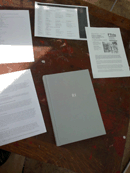
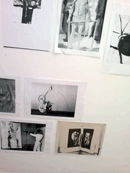
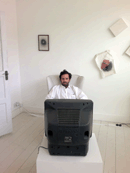
Reprise /ri’pri:z/ n. & v. : n. 1 A repeated passage in music. 2. A repeated item in a musical programme. v.tr. repeat (a performance, song, etc.); restage, rewrite. [French, fem. past part. of reprendre]
What remains of an exhibition, once it has run its course, is crystallised in its catalogue, the materials it generated, and the memories of those who experienced it. Yet the exhibition that once was is also a material – equal to any other – and as such can be reprised weeks, months or years later, and in different contexts.
A catalogue generally makes available the details of the works that were included in an exhibition. It ‘reproduces’ images of the artefacts that made it be and/or views of the exhibition itself. Catalogues are at best the memory of an exhibition, at worst its checklist. To reprise an exhibition can be seen as an attempt to envisage its memory, to re-insert it in reality, by using its catalogue as a score for another exhibition to be.
Past realities are revisited and appropriated by the presentation of an entire ‘bootleg’ of an exhibition. To do so is to curate an exhibition without choosing any of the works. The original artworks are copied, their reproductions insisting on their equivalence to the original. From the catalogue's checklist, an approximation of all the artworks is gathered and united in a format that only has to be printed in order to generate another bootleg ; a distant echo of the original, an exhibition evolving from what once was and in constant expansion.
Mathieu Copeland, July 2011
Studies for an Exhibition, David Roberts Art Foundation - London 07/04 - 11/06 2011
Opening: 06/04 @ 18.30
curators’ series # 4
Studies for an Exhibition
07.04.2011 -11.06.2011.
please join us for the opening: 06.04. 2011 from 6.30
With Elena Bajo, Robert Barry, Emma Bjornesparr, Jarrod Fowler, Nicolas Garait, Karl Holmqvist, Bethan Huws, David Medalla, Gustav Metzger, Roman Opalka, Julia Rometti & Victor Costales, Karin Sander, Yann Sérandour, Cally Spooner, Sue Tompkins, and Niele Toroni.
an exhibition by Mathieu Copeland.
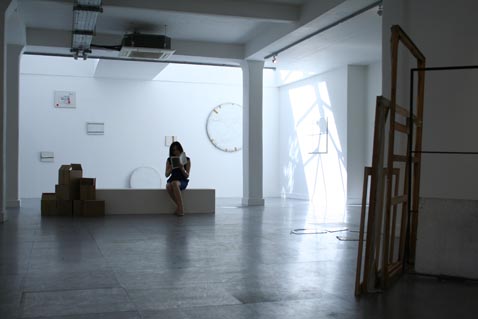
Mathieu Copeland is the fourth guest curator invited by The David Roberts Art Foundation to be part of the Curators’ Series. Studies for an Exhibition, explores how exhibitions are to be envisaged in regard to transient thoughts – an art that reveals itself through time, as movements of transitions, as possible studies giving the feeling of what is, and what can be.
Following a desire to not fix in form an exhibition to be, Studies for an Exhibition brings together practices that explore the possibilities of immateriality and the temporal nature of an art object. The question of time and accumulation is adamant to an exhibition that considers a recycling of our current reality as the means to generate transitory new forms.
Moments of history are revisited, as with the recreation of Gustav Metzger’s 1956 display/appropriation of the posters advertising the seminal show at the Whitechapel Gallery This Is Tomorrow, which he used to cover the entire shop windows of his then second hand shop/exhibition space 30Queens in Kings Lynn. A means to advertise what was tomorrow then, the posters can be read in parallel to the altered exhibition posters by Niele Toroni, who painted over posters advertising his own exhibitions, thereby blurring the moment of the original shows and when these are painted, and shown. Past realities are again revisited and appropriated when confronted with the entire ‘bootleg’ of a 1964 ICA exhibition entitled Study for an exhibition of violence in contemporary art.
In relation to these works of past and present readings, the ‘mailed paintings’ by Karin Sander create in the space of the gallery an unstable hanging as these are being mailed back and forth to the artist in Berlin for the duration of the exhibition. The paintings capture their own reality by acquiring marks as they travel unprotected from one place to the next. As an echo to this reality in motion for an exhibition to be, Emma Bjornesparr addresses the location of the gallery and the habits of consumption. Through a temporary sculpture that frames the entire time of an exhibition in saving the accumulated waste, the artist creates the inversed portrait of the host institution.
Since 1972 Roman Opalka marks time through the progressive inscription of numbers painted from one to infinity. The constant evolution of these paintings is accompanied by a tape recording of his own voice saying the numbers out loud as he writes them. By disseminating these recordings in the space of the gallery we are projected into an ephemeral experience of time.
Accumulation of knowledge is the focus of Julia Rometti and Victor Costales’ work. Exotismo Ordinario Internacional Neotropical is an archive based on their ongoing research into plants from the neotropical region. As part of this continuous study, a series of booklets will be handed out. Elena Bajo’s commission is to be dreamt, forgotten, drawn on a wall or indeed erased. Showing the process of becoming, it is a piece that is all of its studies, changes and potentialities, echoing the exhibition in becoming a study for all that it can and could be.
And as yet another possible study discussing the form of an exhibition, Mathieu Copeland has edited a new publication, the third volume of his series entitled An Exhibition to Hear Read/Une Exposition à être lue. The book will be read out at 2pm every day for the duration of the exhibition. This publication features text based artworks by Robert Barry, Jarrod Fowler, Nicolas Garait, Karl Holmqvist, Bethan Huws, David Medalla, Yann Sérandour, Cally Spooner, and Sue Tompkins. These contributions consider the relation between a text as an art piece to be and its spoken realisation, questioning the ‘performativity’ of the act of reading from a book.
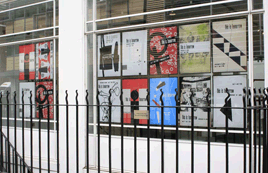
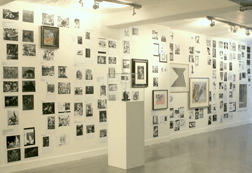
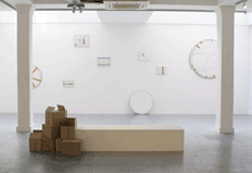
The exhibition is supported by the National Lottery through Arts Council England, the French Institute, London, Swedish Embassy in London and Accion Cultural Espanola, London.
the DAVID ROBERTS ART FOUNDATION -FITZROVIA
111 GREAT TITCHFIELD STRET , LONDON W1W 6RY
TEL : +44 20 7637 0868, WWW.DAVIDROBERTSARTFOUNDATION.COM
OPENING HOURS : TUESDAY -FRIDAY 10AM - 6PM , SATURDAYS 11AM - 4PM
Une Chorégraphie Polyphonique & Une exposition à être lue (volume 2), LiveInYourHEAD Genève 13/01/2011 - 19/01/2011
VERNISSAGE: 13/01/2011 @ 18.00
UNE CHOREGRAPHIE POLYPHONIQUE & UNE EXPOSITION A ETRE LUE (VOLUME 2)
Avec Marí Alessandrini, Sacha Béraud, Emma Bjornesparr, Jérémy Chevalier, Chloé Delarue, Kenneth Goldsmith, Anne-Sylvie Henchoz, Jean-Christophe Huguenin, Livia Johann, Tom Johnson, Franck Leibovici, Véronique Portal, Lili Reynaud Dewar, Tatiana Rihs, Daphné Roulin, Cally Spooner, Irena Tomažin, Anne Le Troter et Martina-Sofie Wildberger
Une exposition de Mathieu Copeland
Vernissage le jeudi 13 janvier à 18 heures
Exposition du 14 au 29 janvier 2011
Du jeudi au samedi de 14 à 19 heures
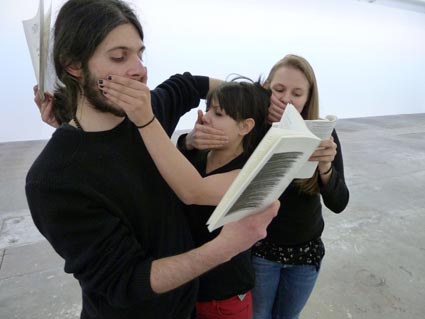
LiveInYourHead
Institut curatorial de la Head – Genève
Rue du Beulet 4, 1203 Genève
Une Chorégraphie Polyphonique & Une Exposition à Etre Lue (Volume2) est la première d’une série de lab.zones (ateliers) conçues par Mathieu Copeland au sein du programme work.master de la Head – Genève, en collaboration avec un groupe d’étudiant-e-s-artistes et avec les contributions de différentes figures invitées.
L’exposition s’articule autour de la question du mot, des mots imprimés dans un livre à être lu aux mots lus dans un mouvement à trois voix, pour former une Chorégraphie Polyphonique. Le pouvoir évocateur des trois mouvements est interprété par la voix, que ce soit à l’unisson, dans la simultanéité, la répétition, ou encore la succession et le geste. L’exposition est uniquement composée d’oeuvres textuelles, écrites par les artistes et conçues pour être lues à trois voix en permanence durant les horaires d’ouverture de l’espace LiveInYourHead. L’exposition est envisagée comme une forme vivante, minimale, continue, vocale autant que mentale, intellectuelle autant que corporelle.
Sa réalité textuelle, la texture du mot et sa qualité lue posent les questions de la gestuelle de la parole, du mouvement des mots et celle de l’inscription du geste de lire dans l’espace d’exposition lui-même. L’interprétation des oeuvres écrites révèle autant l’architecture sensible de l’espace qu’une réalité abstraite et éphémère, portée par la voix, une polyphonie constructive et destructive du contenu intelligible, dans l’espace et le temps.
Approchant l’oeuvre par sa matérialité, et envisageant par là même la matérialité de l’exposition au travers du mot et de la parole, cette Exposition à être lue se cristallise au sein d’une publication. Celle-ci regroupe des oeuvres – écrites par les étudiant-e-s-artistes et les artistes, musiciens ou encore poètes internationaux invités pour l’occasion – qui constituent autant sa partition que sa mémoire.
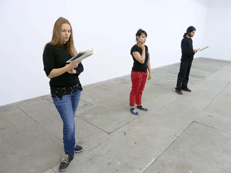
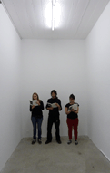
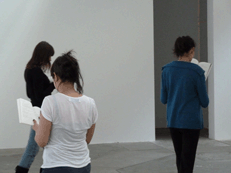
Plus d'information - http://head.hesge.ch/IMG/pdf/LIYH_Mathieu_Copeland-2.pdf
An exhibition of the word(s) on UbuWeb - August 2010
A. Dziga Vertov Group - Letter to Jane
B. Michael Snow - So this is
C. Franck Leibovici - 9+11 [PDF]
D. Karl Holmqvist - Rockland
E. Meredith Monk - As if it came from an oral tradition from Chicago '82: A Dip in the Lake
F. James Lee Byars - Pronounce perfect until it appears, 1979, 0'03" from Happy New Ear
G. Salvador Dali - La Méthode Paranoïaque Critique from Je Suis Fou De Dalí!
H. Gilbert and George - Ten Commandments for Gilbert and George
I. Keren Cytter - Der Spiegel
J. Bob Cobbing - Performing Concrete Poetry [here] and [here]
K. Erica Baum - Body Language [PDF]
L. Bern Porter - The Last Acts of St. Fuck You [PDF]
An exhibition of the word(s), Featured Resources for August 2010 selected by Mathieu Copeland for UbuWeb
"... avant il n'y avait rien, après on va pouvoir faire mieux.", une exposition de motifs et desseins à Circuit, Lausanne 18/06 - 04/09 2010
VERNISSAGE: 18/06 @ 18.30
CIRCUIT
Centre d’art contemporain
Av. de Montchoisi 9, accès quai Jurigoz
case postale 303, CH - 1001 Lausanne
+41 21 601 41 70
www.circuit.li
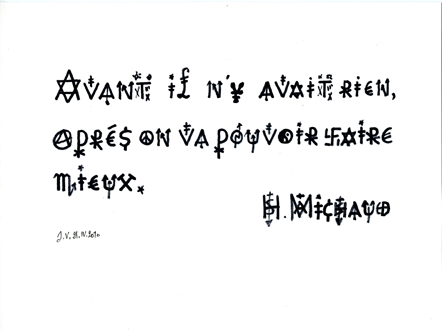
Une exposition de motifs et desseins d’Alan Vega et Antonin Artaud, Kurt Seligmann, Ad Reinhardt, Paul Sharits, Emma Kunz, Glenn Branca, Gustav Metzger, Wallace Berman, Phoebe Unwin, Claude Parent, Jon Savage, Unica Zürn, Madelon Vriesendrop, Charles Burns, Judy Chicago, Brion Gysin, Amélie Dubois, Savage Pencil, Hans Hartung, Asger Jorn, André Masson, Max Kohler, Henri Michaux, Mel Bochner, Steve Albini, Dinos Chapman, Jake Chapman, Jean Tinguely, Max Ernst, Gerhard Rühm, Tadeusz Kantor, NPA, Bruce Conner, Marty Rev, Bob Cobbing, Linder Sterling, Frank Kozik, George Maciunas, Leonora Carrington, Henry Flint, Henri Chopin, Georges Brecht, Le Freistilmuseum, Loulou Picasso, Yoko Ono, Scott King, Rudolph Grey, A.R. Penck, Michael Snow, J.G. Ballard, Salvador Dali, Paul “Cool P” Liebegott, Wyndham Lewis, Jacques Villeglé, Karl Holmqvist, Jacques Bonnard, Ric Ocasek, Marian Zazeela, Delphine Coindet, Genesis Breyer P-Orridge, Warren Neidich, Hans Bellmer, Natacha Anderes, Peter Fischli, Roland Topor, Virginia Overton, Andrea Merkx, W. C. Westermann, Fabrice Stroun et tant d’autres.
un inventaire partiel de Mathieu Copeland et Circuit
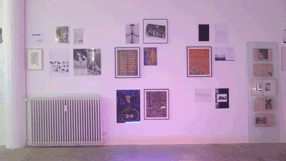
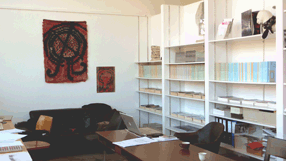
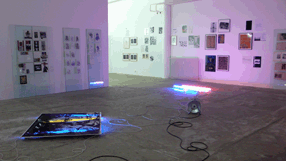
* Préambule d’Henri Michaux à son film “Images du monde visionnaire” de 1964
Le dessin, dans toute sa complexité et sa diversité, existe peut-être et avant tout par son apparente économie. La simplicité possible d’une feuille et d’une technique, un moment pris, une surface remplie. Envisageant le motif et son dessein, l’exposition offre une ouverture nécessaire sur l’écriture et l’art imprimé au travers du dessin et de ces formes possibles de diffusion.
Cette exposition s’offre au regard d’une large sélection d’œuvres dessinées et imprimées d’Alan Vega (né en 1938 à Brooklyn), et accompagnant la sortie de l’ouvrage rétrospectif sur l’œuvre de cette figure mythique de la scène alternative artistique New Yorkaise et pionner du rock électronique minimal en tant que cofondateur avec Martin Rev du groupe culte Suicide. Sur plus de 40 ans de création et d’intensité, Alan Vega s’est affirmé comme l’un des artistes et musiciens les plus influents, faisant du Punk le manifeste d’une raison de vivre.
Cofondateur en 1969 de MUSEUM A Project of Living Artists à New York, un des premiers lieux alternatifs « artist-run spaces » new-yorkais et ouvert 24h/24, MUSEUM était dédié à toutes les formes d’art, aussi bien visuelles que musicales et cinématographiques, devenant rapidement un tremplin pour un grand nombre d’artistes et de musiciens. Vega écrit alors les « Requêtes du Front de Libération du MUSEUM », une série d’injonctions nécessaires et tellement actuelles incluant par exemple ce cri pour que « les systèmes d’exposition, y compris les sélections pour les expositions collectives, soient abolis. » ou encore donnant « le droit à n’importe quel artiste de retirer une œuvre, de modifier une œuvre, de détruire une œuvre de n’importe quel autre artiste présentant son travail dans l’espace » - un texte signé par un Artiste Américain Anonyme du 20e siècle- qui accueille aujourd’hui les visiteurs entrant à CIRCUIT.
À la fin des années 50, Alan Vega étudie notamment avec Ad Reinhardt et Kurt Seligmann au Brooklyn College, et se concentre dans un premier temps sur la peinture, puis le dessin. À la fin des années 60, son intérêt se porte sur la lumière : il crée ses premières « light sculptures », des sculptures lumineuses faites d’assemblage d’objets divers composées d’ampoules, de câbles, de télévisions et de néons de toutes formes et couleurs. Anti-esthétique, antiforme, le pendant d’un Arte Povera « Made in USA », son œuvre embrasse la réalité contemporaine dans laquelle il vit.
L’exposition se concentre principalement autour de son œuvre graphique. Vega insiste comment « pour (lui), le dessin a toujours été un devoir, (et) la peinture une douleur ». Dessinant quasi uniquement des visages, il déclare avoir toujours « aimé dessiner des personnes âgées. Elles ont l’image de la vie gravée sur leur visage ». Activité parallèle et nécessaire à son travail musical, Vega ne peut écrire sans dessiner : « Tout comme l’écriture, dessiner constitue une obsession quotidienne. Comme pour l’écriture, faire un dessin surgit subitement. Avec le dessin, il faut partir ailleurs, quelque part où je n’en ai rien à foutre. Je m’assois, l’esprit absent et en paix (…). C’est une manière de mettre à plat
des idées ».
L’exposition se propose ainsi comme un écho suicidaire au désir d’une exposition qui n’est autre qu’un inventaire morcelé et subjectif.
Son agencement reflète le système d’écriture possible d’une exposition entendue comme le manifeste concrétisé d’une poésie qui se montre. Le chant de mille voix entamant un anthem ou le dessin est l’égale de sa reproduction. Envisageant l’ensemble des œuvres présentes ou suggérées comme un environnement sensible, toutes s’écrivent dans l’espace comme une partition à lire abstraitement.
Oscillation sensée de pièces ultra-figuratives qui (se) composent de nouvelles figures et identités poétiques, au contrepoids composé d’une large sélection d’œuvre abstraite, toutes s’offrent à être lues comme la « carte mentale d’une exposition ». Cette phrase devient à son tour le titre de l’ouvrage photocopié mis à disposition au public, un recueil ou se retrouve mis au même niveau toutes les œuvres constituant cette exposition.
Les rapports, cohésions ou rejections qui s’opèrent entre chacune des parties constituantes de se regroupement temporaire insistent sur la base qui les unies toutes - le dessin, et ses modes possibles de diffusion. D’un médium à l’autre s’affirme une équivalence sur la valeur nécessaire des œuvres présentées.
Hasard arrangé par la géométrie, hors d’une utopie moderne, cet agencement éphémère offre un va-et-vient d’objets référencés, et reproduits… Et si ce qui au départ s’offrait comme un vide premier laissant toutes formes de futures possible, permettons nous de conclure avec une autre phrase d’Henri Michaux, une phrase autant tiré de son magnifique ouvrage de 1948 ‘Meidosems’
qu’extraite – pour l’instant – de l’exposition :
« Ils ont abouti ici. Et il n’y a rien à ajouter ».
Mathieu Copeland et Philippe Decrauzat
UNE EXPOSITION (DU) SENSIBLE, La synagogue de Delme 11/06 - 19/09 2010
VERNISSAGE: 11/02 @ 18.30
Avec/With, par ordre d'apparition/in order of appearance, Gustav Metzger, Cildo Meireles, Dexter & Sinister, Franck Leibovici, Kenneth Goldsmith, Cesare Pietroiusti, Benoit Maire, Goldin + Senneby, Keren Cytter, Amélie Dubois, Charlotte Moth, Cally Spooner, Falke Pisano
Une exposition de/An exhibition by Mathieu Copeland
La synagogue de Delme
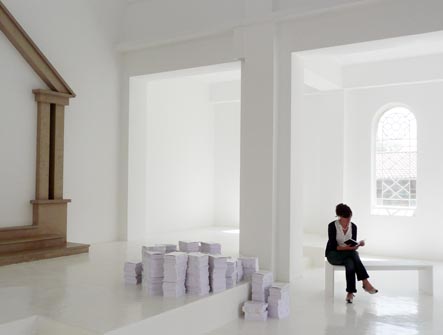
VERNISSAGE LE VENDREDI 11 SEPTEMBRE À 18 H 30
Mathieu Copeland s’est précédemment illustré dans la conception d’expositions renégociant le rapport du spectateur aux œuvres, et des œuvres aux lieux censés les rendre visibles. Vides, une rétrospective, au Centre Pompidou à Paris rassemblait ainsi neuf expositions « vides » de l’histoire de l’art. Une Exposition Chorégraphiée, au Centre d’art de la Ferme du Buisson présentait des œuvres conçues pour être dansées par trois performeurs, selon une partition d’enchaînements écrite par le commissaire. Dans Une Exposition Parlée, elles étaient lues et activées par l’équipe du centre d’art Baltic de Newcastle upon Tyne. Évoquons enfin Soundtrack for an exhibition au Musée d’Art Contemporain de Lyon, immense partition musicale étirée sur plusieurs mois, où la musique devenait l’exposition à proprement parler. D’exposition en exposition, Mathieu Copeland dessine une manière de faire et de pousser la forme artistique tout comme l’institution dans leurs retranchements. Qu’elles soient musicales, parlées, chorégraphiées, les œuvres placent le spectateur en position de jouer à son tour sa partie, tout du moins de dépasser le vide apparent pour écouter, se mouvoir, capter de tous ses sens l’air et la réalité qui l’entoure.
Partant d’une conversation avec l’artiste Gustav Metzger, pionnier de l’Art Autodestructif depuis 1959, Mathieu Copeland réaffirme avec lui qu’il ne s’agit pas d’utiliser l’exposition pour montrer des objets dans un espace physique déterminé, mais de réaliser ces objets, envisageant alors la synagogue de Delme comme le lieu d’où l’on part, et non plus comme une fi n en soi ni un point d’arrivée. Plutôt un passage...
Les œuvres produites s’affranchissent des limites habituelles de l’exposition pour s’insérer dans la vie et l’économie d’un territoire. Les réseaux locaux, qu’il s’agisse de médias, d’évènements ou de services, deviennent tout à la fois le support et le lieu d’apparition des œuvres. C’est le cas du film de Franck Leibovici projeté tout l’été en première partie des films de cinéma itinérant en Lorraine, de la pièce radiophonique de Kenneth Goldsmith diffusée chaque jour via des radios locales, des interventions hebdomadaires de Cesare Pietroiusti dans le journal, sous forme de « pensées non fonctionnelles », ou encore du Bulletin Municipal 2010 de la commune de Delme, revisité par le duo Dexter & Sinister et à partir duquel sont déclinés les supports de communication pour Une exposition (du) sensible. Le titre renvoie à l’ancrage de tout le projet dans une réalité sensible, qu’elle soit entre les quatre murs blancs du centre d’art ou dans les boîtes aux lettres des habitants de Delme, qui ont reçu chez eux le fameux Bulletin.
Si le centre d’art devient la caisse de résonnance d’œuvres qui ont lieu ailleurs, il est aussi une structure vivante, qui rassemble des objets mouvants, activés et activables : l’œuvre que Cildo Meireles a conçu en 1970, intitulée Insertions dans des circuits idéologiques, consiste à « enregistrer des informations et des opinions critiques sur des billets de banque et les remettre en circulation ». L’artiste s’employait alors à tamponner les billets, avec ce titre et cette phrase, assortis de messages militants, avant de les réinjecter dans le flux des échanges bancaires. L’œuvre est ainsi réactivée dans le cadre d’Une exposition (du) sensible. Si le texte, le langage, la lecture et la parole sont conviés au fil des œuvres de multiples manières, le livre édité spécialement pour l’exposition, intitulé Une exposition à être lue, condense tout particulièrement cette dimension. Il rassemble les contributions de Keren Cytter, Amélie Dubois, Goldin+Senneby, Benoît Maire, Charlotte Moth, Falke Pisano et Cally Spooner : narrations, descriptions d’espaces imaginaires, protocoles de lecture, scripts d’œuvres filmiques renvoient à la matière textuelle au cœur du travail de ces artistes, fascinés par le langage et sa puissance d’évocation. La lecture des œuvres écrites révèle autant l’architecture sensible d’un espace, celui de la synagogue, mais pas seulement : une réalité sensible et éphémère, portée par la voix. Une exposition (du) sensible déjoue les cadres spatiaux et temporels dans lesquels on circonscrit les œuvres, ainsi que le fonctionnement lissé des institutions, une sorte de science aigüe du glissement et de la dissémination des formes. Certaines œuvres ont déjà eu lieu, d’autres auront lieu après-coup, comme c’est le cas de l’intervention de Gustav Metzger dans la presse locale en octobre. Le centre d’art se fait articulation, de temps et de lieux, mais aussi de mots et de phrases, qu’elles soient écrites, lues ou parlées.
Marie Cozette
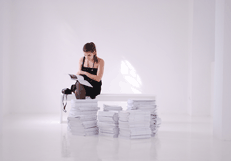
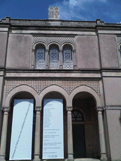
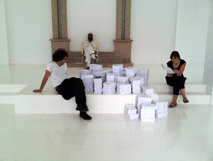
Engaging with a practice that often considers immateriality, Mathieu Copeland proposes exhibitions that renegotiate the relationship between the spectators and the works, and between the works and the venues supposed to give them visibility. “Voids, a Retrospective” at the Centre Pompidou in Paris brought together nine historical “empty” exhibitions; “A Choreographed Exhibition” at the Ferme du Buisson Contemporary Art Centre presented artworks as gestures and movements that were danced by a trio, written in time by the curator; in “A Spoken Word Exhibition” the works were read aloud by the staff of Baltic, Newcastle upon Tyne’s contemporary art centre; or again with “Soundtrack for an Exhibition”, a seemingly timeless score stretched out over several months at the Museum of Contemporary Art in Lyon, the music actually becoming the exhibition.
From one venture to the next, Mathieu Copeland has outlined a way of working that subjects artistic forms and institutions to radical challenges. May these be of sound, to be spoken or danced, the works place the viewer in the situation of having to play his own part in turn – or at the very least of having to transcend a seeming void so as to listen, move about and tune in sensorially to an atmosphere and its surrounding reality.
Referencing a conversation with Gustav Metzger, the seminal activist and pioneer of auto destructive art, Copeland joins the artist in reaffi rming that the exhibition should serve not to show things in a predefifi ned physical space, but to realise them; the Synagogue de Delme is thus taken as a point of departure, and not as an end in itself nor a destination. More a transient place.
Breaking out of the usual exhibition boundaries, the works inhabits the specifi c life and economy of a given territory. Local networks – media, events, services – become simultaneously the medium and the venue for the works. Such is the case for Franck Leibovici’s fi lm, shown before all the features that will be shown this summer as part of the itinerant cinemas circuit in Lorraine; Kenneth Goldsmith’s daily piece on local radios; Cesare Pietroiusti’s weekly “non-functional thoughts” in the press; and the Municipality of Delme’s Bulletin for 2010, revisited by the duo Dexter & Sinister and serving as the publicity basis accompanying “Une Exposition (du) Sensible”. The title, that could be translated as “A Sensibility Exhibition” or “An Exhibition of the Sensible”, refers us to the project’s roots in a perceptible reality, may this be within the art centre’s four white walls or through the letter boxes of Delme, as every inhabitant of the town received a copy of the Bulletin.
While the art centre thus becomes a resonance chamber for works happening elsewhere, it is also a living structure, an assembly point for mobile objects both activated and activatable: Cildo Meireles’ Insertions into Ideological Circuits from 1970 which involves “recording information and critical opinions on banknotes and reintroducing them into circulation”. At the time the artist stamped the notes with this title, as a call to the addition of political messages, before reintroducing them into the fl ow of the banking system. This work, is, once again, reinserted for the time of the exhibition.
If text, language, reading and speech appear to be the basis of the works composing this exhibition, the book specially published for the exhibition and titled An Exhibition To Hear Read provides a singular condensation in the form of contributions by Keren Cytter, Amélie Dubois, Goldin+Senneby, Benoît Maire, Charlotte Moth, Falke Pisano and Cally Spooner: narratives, descriptions of imaginary spaces, reading protocols and fi lm scripts (...) all reference the textual matter central to the work of these artists fascinated by language and its powers of evocation. A reading of the written works reveals not only the perceptible architecture of any given space – that of the synagogue – but also a perceptible and ephemeral reality channelled through the voice.
“Une Exposition (du) Sensible” thwarts both the circumscribing of works by spatial and temporal frameworks and the bland functioning of art institutions, that highly developed pseudo-science of displacement and dissemination of forms. Some of the works have already taken place, others will happen at a later stage: Gustav Metzger’s contribution via the local press is scheduled for October. The art centre thus functions as a point of articulation for times and places, but also for words and phrases, whether written, read or spoken.
Marie Cozette
AUTOUR DE L’EXPOSITION
Visite commentée avec Mathieu Copeland : dimanche 12 septembre à 16h
Visites commentées avec Laurène Macé, chargée des publics : tous les dimanches à 16h
INFORMATIONS PRATIQUES
Vernissage de l’exposition vendredi 11 juin à partir de 18h30,
en présence des artistes et de Mathieu Copeland.
Exposition ouverte du 11 juin au 19 septembre 2010.
Mercredi-samedi : 14-18h & dimanche : 11-18h. Entrée libre et gratuite.
Le centre d’art sera ouvert le 14 juillet et le 15 août.
POUR SE RENDRE À LA SYNAGOGUE DE DELME
ACCÈS DEPUIS PARIS (1h30):
TGV Est, arrivée Metz ou Nancy
ACCÈS DEPUIS METZ (1/2h):
D955, ancienne route de Strasbourg
ACCÈS DEPUIS NANCY (1/2h):
N74 direction Château-Salins
puis D955 vers Metz
Visuels disponibles sur demande
Contact presse: Agathe Borgne communication@cac-synagoguedelme.org / +33(0)3 87014342
L'EXPOSITION CONTINUE (ECHO), CNEAI 09/02 - 18/04 2010
VERNISSAGE: 07/02 @ 14.00-18.00
Des peintures de Birgir Andresson, Francis Baudevin, Jean-Sylvain Bieth, Stefan Brüggemann, Michel Castaignet, John Cornu, Stéphane Dafflon, Philippe Decrauzat, Noël Dolla, Olivier Mosset, Christian Robert-Tissot, Josh Smith, Evi Vingerling, Robert Barry, Ditte Ejlerskov (…) repeintes de la même couleur que le mur par Claude Rutault.
Une exposition de Mathieu Copeland.
Du 09/02 au 18/04 2010
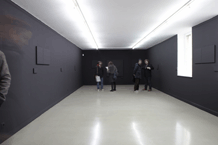
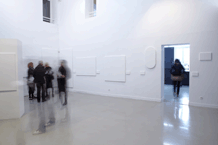
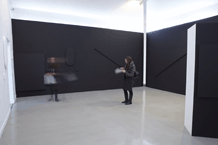
Inauguration dimanche 07/02 de 14h à 18h
Navette gratuite Place du Châtelet 13h30
cneai =
tél : 01 39 52 45 35, fax : 01 39 52 43 78,
cneai@cneai.com, île des impressionnistes, 78400 chatou, france
"L’exposition présente des peintures de Birgir Andresson, Francis Baudevin, Jean-Sylvain Bieth, Stefan Brüggemann, Michel Castaignet, John Cornu, Stéphane Dafflon, Philippe Decrauzat, Noël Dolla, Olivier Mosset, Christian Robert-Tissot, Josh Smith, Evi Vingerling, Robert Barry, Ditte Ejlerskov (…) repeintes de la même couleur que le mur par Claude Rutault .
S’offrant comme une réflexion sur ce qu’est la peinture, l’exposition se fragmente en plusieures expositions concomitantes. En premier lieu, une exposition classique de peintures de différents artistes ; peintures qui sont, suivant le principe fondamental de l’œuvre de Claude Rutault initié en 1972, repeintes de la même couleur que le mur, affirmant ainsi une deuxième exposition. En écho s’offre une troisième exposition fantôme, des toiles monochromes de Claude Rutault au format identique aux peintures repeintes insérées au sein même de l’architecture du Cneai. Une exposition en miroir (et en échange), qui s’inscrit ainsi comme un écho vide du présent des œuvres."
Mathieu Copeland
Co-production : Circuit & 1m3 – Lausanne Suisse
Paintings painted over with the same colour of the wall by Claude Rutault.
" The exhibition shows paintings by Birgir Andresson, Francis Baudevin, Jean-Sylvain Bieth, Stefan Brüggemann, Michel Castaignet, John Cornu, Stéphane Dafflon, Philippe Decrauzat, Noël Dolla, Olivier Mosset, Christian Robert-Tissot, Josh Smith, Evi Vingerling, Robert Barry, Ditte Ejlerskov (…) painted over with the same colour of the wall by Claude Rutault.
Thought out as a reflexion on the nature of painting, the exhibition is fragmented in a couple of echoing exhibitions. To begin with, there is a classical exhibition of paintings by different artists ; these paintings are, following the fundamental principle of Claude Rutault's work started in 1972, paintd over with the same colour of the wall on which they are hung, affirming thus a second exhibition. Echoing these, a third, fantomatic exhibition is given constituted by monochrome paintings by Claude Rutault of the same formats than the ones painted over inserted within the cneai's architecture. A mirror exhibition, such as an empty echo of the works' present." Mathieu Copeland
Co-production : Circuit & 1m3 – Lausanne Suisse
Voids, Eine Retrospektive, Kunsthalle Bern
13 Septembre / 11 Octobre 2009
Voids, Eine Retrospective
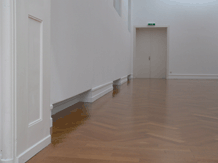
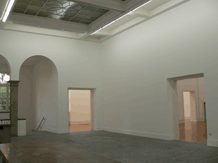
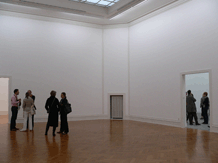
With VOIDS, EINE RETROSPEKTIVE the Kunsthalle Bern offers an opportunity to explore a crucial chapter in the history of art. Following Yves Klein’s exhibition at the Iris Clert gallery in 1958, the empty space became a recurrent artistic theme. This chronological retrospective exhibition brings together nine empty exhibitions by Yves Klein, Art & Language, Robert Barry, Robert Irwin, Stanley Brouwn, Bethan Huws, Maria Eichhorn, and Roman Ondák.
Yves Klein’s 1958 emblematic exhibition ‘The Specialization of Sensibility in Raw Material State into Stabilized Pictorial Sensibility’, which was subsequently referred to as The Void, is widely considered as a turning point in modern art history. The empty space exhibited as such thus became, in a way, a classic of radicalism, and would be repeated and remade in other contexts, other places and other times by other artists whose intentions might be similar, different or even opposed to Klein’s.
The principle of the exhibition at the Kunsthalle Bern is to present only exhibitions where the space is left rigorously empty, without the addition or subtraction of anything, thus excluding, for instance, shows or works involving the modification of lighting, the installation of sound, the construction of partitions or the exclusion of the public. And it is no part of its goal to reconstruct the original physical space, as rather than representing the historical void by the artists, the retrospective - working closely with the artist and their estate - considers the void itself, and not the architecture that hosted the void.
Also, all forms of historical documentation or memorabilia related to the original exhibition (such as posters, photos, invitations, photo-documentation, press reviews, original texts) are excluded from the exhibition; all such elements being included in the exhaustive catalogue published alongside the exhibition, edited by the curators John Armleder, Mathieu Copeland, Mai-Thu Perret, Clive Phillpot, Gustav Metzger, together with Laurent Le Bon and Philippe Pirotte.
Each void offers a different reading of the empty space, representing, perhaps, a claim, a renunciation, or, indeed, a celebration of the museum or gallery’s space. Contemplating emptiness, one confronts nothingness and absence, the invisible and the ineffable, destruction and negation. VOIDS are offered for what they are, and for what they allow. This accumulation of empty spaces, similar in appearance but radically different in reality, has echoes and implications beyond its walls. More than a radical and conceptual exhibition, the retrospective is an invitation to explore and experience, in a very physical manner, the different texture of each different space. The visitor encounters the empty exhibitions now in 2009, exactly 40 years after ‘When Attitude Become Form’ organised by Harald Szeeman when director of the Kunsthalle Bern. It was such exhibition that enabled this retrospective to be, and one could dream that with the voids, the attitudes, literally, are the forms.
This exhibition brings together the work of artists who have attempted this extreme gesture, to exhibit without showing an object, without making any intervention but a single announcement. The exhibition begins with Yves Klein’s 1958 exhibition, and from then on envisages how entirely empty exhibitions have defined different kinds of emptiness, sometimes as a means to signal sensibility as for Klein, sometimes as the peak of a conceptualist or minimalist practice as with Robert Barry’s ‘Some places to which we can come, and for a while “be free to think about what we are going to do (Marcuse)”’ (1970). Sometimes as the desire to explore our understanding of exhibition & exhibition spaces as for Art & Language’s ‘Air Conditioning Show’ (1966-67), or in the case of Robert Irwin’s ‘Experimental Situation’ (1970) as the appraisal of the space, and the affirmation that there is no such thing as nothing. Sometimes as the desire to empty an institution & focus on the experience of walking through it as for Stanley Brouwn, or with Laurie Parsons’ exhibition at the Lorence-Monk Gallery in New York in 1990, announced by a card bearing only an address, with neither dates nor the name of the artist, as a means to announce the artist’s complete withdrawal. Sometimes as the affirmation that there is no need to introduce in a space a work of art as it is already there, as with Bethan Huws’ ‘Haus Esters Piece’ (1993). And again as with Maria Eichhorn’s ‘Money at the Kusnthalle Bern’ who in emptying the Kusnthalle in 2001 worked with the void out of necessity, devoting the exhibition budget to the renovation of the building. And sometimes it is the means to remind us that the most important aspect of any void is the notion of trust and belief, as with Roman Ondak’s ‘More Silent Than Ever (room fitted with eavesdropping devices)’ (2006), a piece that deceives the public in making one believe that there is more when indeed there is nothing.
In this respect, from the search for a renewal of perception, through political or ideological statement, to the deconstruction of the very principle of exhibition, these exhibitions pose a range of crucial questions about the role of the institution, and this unprecedented marshalling of eloquent emptiness within the Kunsthalle Bern represents a true challenge to the institution.
For an unprecedented exhibition, a unique curatorial team. VOIDS, A RETROSPECTIVE, which is both an exhibition in the most traditional sense and an art event in its own right, has been put together by John Armleder, who has always been interested in nothing; Gustav Metzger, a key figure in auto-destructive art, Mai-Thu Perret, a young conceptual artist, Mathieu Copeland, a curator who explores the limits of the exhibition, Clive Phillpot, a writer; together with Philippe Pirotte, director of the Kunsthalle Bern.
Accompanying and simultaneously to the retrospective at the Kunsthalle Bern, the Museum Haus Lange, Krefeld, will be entirely empty and open to the public for a week (20th - 27th of September) as an invitation to visit Yves Klein’s ‘Raum der Leere’, a permanent void realized in 1961.
Accompanying events will also include an evening of performance by Ben Vautier, a screening of films curated by Stuart Comer, a listening session by Francis Baudevin, and "Absenz - (k)ein konzert" a concert by Ensemble Neue Horizonte. For more information on dates and locations in Bern on all these events, please refer to www.kunsthalle-bern.ch.
VOIDS, EINE RETROSPEKTIVE is coproduced by the Centre Pompidou, Paris, and the Kunsthalle Bern.
ALAN VEGA
INFINITE MERCY
15.05 > 02.08.09
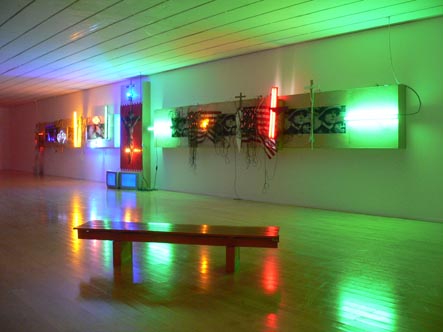
ALAN VEGA, CONNU POUR ÊTRE L’UN DES PIONNIERS DU ROCK ÉLECTRONIQUE MINIMALISTE, COFONDATEUR AVEC MARTIN REV DU GROUPE MYTHIQUE « SUICIDE » AU DÉBUT DES ANNÉES 70, EST AVANT TOUT UN ARTISTE PLASTICIEN ACTIF SUR LA SCÈNE ARTISTIQUE NEW-YORKAISE DÈS LA FIN DES ANNÉES 60.
En 1969, Alan Vega (né en 1938 à New York, où il vit et travaille) est l’un des fondateurs du « Projet des Artistes Vivants » (Project of Living Artists), un des premiers lieux alternatifs new-yorkais, tenu par des artistes et ouvert 24h/24. Dédié à toutes les formes d’art, aussi bien à la musique qu’au cinéma, ce lieu devient vite un tremplin pour un grand nombre d’artistes, tels que New York Dolls, Television et Blondie. Dans cet univers saturé, Alan Vega trouve un environnement idéal pour son oeuvre et poursuit simultanément sa carrière musicale et artistique. Il étudie avec Ad Reinhardt au Brooklyn College et se concentredans un premier temps, sur la peinture. À la fin des années 60, son intérêt se porte sur la lumière et il crée ses premières « light sculptures », assemblages d’objets divers composés d’ampoules, de câbles, de télévisions et de néons de toutes formes et couleurs.
/ LA PREMIÈRE FOIS QUE J’AI RÉALISÉ UNE « SCULPTURE LUMIÈRE » JE TRAVAILLAIS SUR UNE PEINTURE DE GRAND FORMAT DE COULEUR VIOLETTE. UNE SEULE AMPOULE ÉCLAIRAIT LA PIÈCE, ET COMME J’ALLAIS ET VENAIS, J’AI REMARQUÉ QUE LA PEINTURE PRENAIT DIFFÉRENTS ASPECTS. JE N’ARRIVAIS PAS À OBTENIR L’UNITÉ DE COULEUR QUE JE CHERCHAIS […], J’AI DÉCROCHÉ L’AMPOULE DU PLAFOND, ET JE L’AI LITTÉRALEMENT PLANTÉE SUR MA PEINTURE. CELA M’A OUVERT À L’IDÉE MÊME DE COULEUR, ALORS QUE JE VOULAIS LA CONTRÔLER, J’AI COMMENCÉ À VOIR À QUEL POINT LA LUMIÈRE POUVAIT MODIFIER UNE PEINTURE : C’EST LA LUMIÈRE QUI DÉTERMINE LA PEINTURE […]. DÈS QUE J’AI COMMENCÉ À TRAVAILLER AVEC L’ÉCLAIRAGE, J’AI UTILISÉ DE PLUS EN PLUS D’AMPOULES, À LA PLACE DE PIGMENTS. LES AMPOULES DE COULEUR SONT DEVENUES MA PROPRE PALETTE. /
Alan Vega
Anti-esthétique, anti-formelle, son œuvre embrasse la réalité contemporaine dans laquelle il évolue. Faisant fi de toute préciosité, pour l’une de ses toutes premières expositions à New York en 1972, Alan Vega récupère dans la rue les matériaux qui constitueront des éléments de son oeuvre et les présente dans la galerie. À l’issue de l’exposition, il les rend à leur réalité première, les retournant à la rue.
Composée d’un large corpus d’oeuvres créées depuis 1971, cette rétrospective présente un ensemble de sculptures lumineuses, dont les célèbres « crucifix », série initiée au début des années 80. Une version « monumentale » est créée spécifiquement pour l’exposition au Mac LYON.L’exposition présente également un large choix de peintures et plus d’une centaine de dessins exécutés au stylo-bille, totalement inédits :
/ JE DESSINE EXCLUSIVEMENT DES GENS, LES VISAGES M’INTÉRESSENT PLUS QUE TOUT LE RESTE. JE JETTE LA PLUPART DE MES DESSINS. IL FAUT QUE L’INSPIRATION VIENNE DE FAÇON NATURELLE. ELLE VIENT QUAND J’ÉCRIS DES CHANSONS OU DES POÈMES. IL FAUT JUSTE ESSAYER DE PLONGER AU PLUS PROFOND DE SOI-MÊME. POUR ÊTRE FRANC, JE DÉTESTE ÉCRIRE, ET CURIEUSEMENT, JE NE PEUX M’Y METTRE QU’À CONDITION DE DESSINER UN PORTRAIT. /
Alan Vega
Dans la logique de son travail de récupération et d’utilisation de matériaux préexistants, l’exposition comme les oeuvres, recycle, réintègre, un grand nombre de « matériaux » des expositions antérieures : verres, murs, structures…
/ MON ART, C’EST L’ART DE L’OBJET TROUVÉ, ET C’EST AUSSI DE LA RÉCUPÉRATION. /
/ IL NE S’AGIT PAS D’UN ART LISSÉ ET J’APPRÉCIE LE FAIT QU’ELLES SOIENT COMPOSÉES À PARTIR DE DÉCHETS OU DE REBUTS. /
Alan Vega
Légendes vivantes de l’histoire du rock et du punk, précurseurs avant-gardistes, avec Suicide, Alan Vega et Martin Rev sont les premiers musiciens rock à introduire systématiquement le beat millimétré de la batterie électronique dans leurs compositions. Alan Vega est cependant beaucoup moins connu comme artiste plasticien, c’est pourquoi, le mac LYON lui consacre ici, sa première grande exposition personnelle rétrospective, présentant plus de 40 ans de création et d’intensité.
Mathieu Copeland
ALAN VEGA, KNOWN TO BE ONE OF THE PIONEERS OF MINIMALIST ELECTRONIC ROCK AS THE CO -FOUNDER WITH MARTIN REV OF THE MYTHICAL BAND “SUICIDE”, IS FIRST AND FOREMOST A VISUAL ARTIST ACTIVE ON THE NEW YORK SCENE SINCE THE END OF THE 1960S.
In 1969, Alan Vega (born in 1938 in NY, where he still lives & works) was one of the founding members of the “Project of Living Artists”, one of the first alternative artist-run spaces in NY open 24/7. Dedicated to all forms of art, music and cinema, it quickly became a showcase for groups such as the New York Dolls, Television and Blondie. In this saturated universe, Vega found an ideal environment for his work, and pursued his musical and artistic careers in parallel. He studied with Ad Reinhardt at Brooklyn College, initially focusing on painting. Toward the end of the 1960s, his interests shifted toward light as he created his first “light pieces”— assemblages of diverse objects including bulbs, wires, televisions and neon tubes of every shape and colour.
/ THE FIRST TIME I DID A LIGHT PIECE WAS WHEN I WAS WORKING ON A VERY BIG PURPLE PAINTING. THERE WAS ONE LIGHT BULB IN THE ROOM, AND AS I WALKED AROUND I NOTICED HOW THE PAINTING ACQUIRED DIFFERENT ASPECTS. I WANTED IT TO BE ONE COLOUR, SO […] I TOOK THE LIGHT OUT OF THE CEILING AND REALLY STUCK IT ON THE PAINTING. THAT STARTED ME WITH THE WHOLE IDEA OF LIGHT BECAUSE I WANTED TO CONTROL THE COLOUR, BUT THEN I SUDDENLY BEGAN TO REALIZE JUST HOW MUCH LIGHT AFFECTS A PAINTING — ALL PAINTING IS ABOUT LIGHT. […] AS I STARTED WORKING WITH LIGHT, I STARTED GETTING MORE AND MORE INTO DIFFERENT COLOURS OF LIGHT INSTEAD OF USING PAINT. I STARTED USING LIGHT BULBS OF COLOUR THAT BECAME MY PAINT. /
Alan Vega
Anti-aesthetic, anti-formal, Vega’s work embraces the contemporary reality in which he is immersed. For one of his first exhibitions in New York in 1972, eschewing all preciosity, he looked to the streets for the materials that would become the elements of his work, and presented them in the gallery. At the end of the exhibition, he gave them back to their primary reality, returning these to the street.
This retrospective comprises a large corpus of works created since 1971. Presenting numerous light pieces from all periods, among them the famous series of “crucifixes” which Vega began in the mid-1980s, and a “monumental” version created specifically for the exhibition at the mac LYON.The retrospective also presents a large body of paintings, and more than a hundred ballpoint drawings that have not previously been exhibited :
/ I DRAW JUST PEOPLE. TO ME A FACE IS EVERYTHING ANYWAY. MOST OF THE DRAWINGS I THROW OUT. IT JUST HAS TO COME OUT WITHOUT THINKING […] WHEN I WRITE LYRICS, OR POETRY, IT COMES FROM MY MIND. IT’S JUST TRYING TO GET DEEP INTO YOURSELF. TO BE HONEST WITH YOU, I HATE WRITING, AND IRONICALLY THE ONLY WAY I CAN SIT DOWN AND WRITE IS IF I DRAW A PORTRAIT. /
Alan Vega
In the logic of Vega’s work, including the retrieval and re-use of pre-existing objects, it is not just the works, but the exhibition format itself, that recycles and reintegrates various “materials” from previous exhibitions : glass, walls, structures, etc.
/ MY ART IS AN ART OF THE FOUND OBJECT, AND IT’S ALSO THAT OF SALVAGE. /
/ IT’S NOT SMOOTHED-OUT ART, AND I APPRECIATE THE FACT THAT IT’S COMPOSED OF GARBAGE AND DISCARDED OBJECTS. /
Alan Vega
As living legends of rock and punk history, and avant-garde precursors with Suicide, Alan Vega and Martin Rev were the first rock musicians to systematically introduce electronic drums into their compositions. Alan Vega is however less well known as an artist, this is the reason why mac LYON proposes his first major solo retrospective, representing more than 40 years of creativity and intensity.
Mathieu Copeland
Dossier de presse Alan Vega - Infinite Mercy // Service presse Élise Vion-Delphin T +33 (0)4 72 69 17 25 // communication@mac-lyon.com
ALAN VEGA - INFINITE MERCY. Toutes les photographies ©Céline Bertin, 2009
VIDES, Une rétrospective
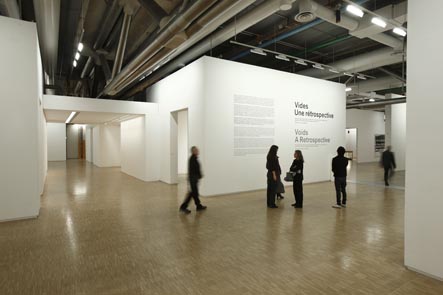
Manifestation exceptionnelle, « Vides » est une rétrospective des expositions vides depuis celle d'Yves Klein en 1958. Dans une dizaine de salles du Musée national d'art moderne, elle rassemble, de manière inédite, des expositions qui n'ont rigoureusement rien montré, laissant vide l'espace pour lequel elles étaient pensées.
L'idée d'exposer le vide est récurrente dans l'histoire de l'art de ces cinquante dernières années, au point d'être presque devenue un cliché dans la pratique artistique contemporaine. Depuis l'exposition d'Yves Klein La spécialisation de la sensibilité à l'état matière première en sensibilité picturale stabilisée à la galerie Iris Clert, à Paris, en 1958, les expositions entièrement vides affirment différentes conceptions du vide.
S'il est pour Yves Klein un moyen de signaler l'état sensible, il représente en revanche l'apogée de l'art conceptuel et minimal pour Robert Barry avec Some places to which we can come, and for a while "be free to think about what we are going to do." (Marcuse), [« Des lieux où nous pouvons venir, et pour un moment, ' être libre de penser à ce que nous allons faire '. (Marcuse) »], œuvre initiée en 1970. Il peut aussi résulter du désir de brouiller la compréhension des espaces d'expositions, comme dans l'œuvre The Air-Conditioning Show d'Art & Language (1966-1967), ou de vider une institution pour modifier notre expérience comme dans l'oeuvre de Stanley Brouwn.
Il traduit également la volonté de faire l'expérience des qualités d'un lieu d'exposition, comme pour Robert Irwin et son exposition réalisée à la ACE Gallery en 1970, ou pour Maria Nordman lors de son exposition à Krefeld en 1984. Le vide représente aussi une forme de radicalité, comme celui créé par Laurie Parsons en 1990 à la galerie Lorence-Monk, qui annonce son renoncement à toute pratique artistique. Pour Bethan Huws et son œuvre Haus Esters Piece (1993), le vide permet de célébrer l'architecture du musée, signifiant que l'art y est déjà présent et qu'il n'est pas nécessaire d'y ajouter des œuvres d'art. Le vide revêt presque le sens d'une revendication économique pour Maria Eichhorn qui, laissant son exposition vide à la Kunsthalle Bern en 2001, permet d'en consacrer le budget à la rénovation du bâtiment. Avec More Silent than Ever (2006), Roman Ondak, quant à lui, laisse croire au spectateur qu'il y a plus que ce qui est laissé à voir.
Comité Curatorial : John Armleder, Mathieu Copeland, Gustav Metzger, Mai-Thu Perret, Clive Phillpot.
Commissaire au Centre Pompidou: Laurent Le Bon
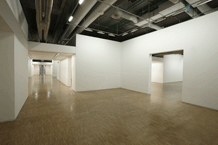
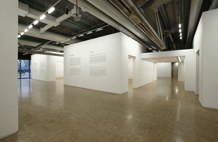
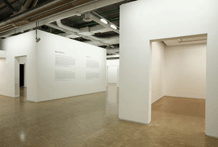
VIDES. Une rétrospective. Toutes les photographies © Centre Pompidou, Georges Meguerditchian, 2009
VIDES
Edité par JRP-Ringier
Vides. Une rétrospective est une exposition paradoxale : à travers la réactualisation de neuf «expositions vides», elle apparaît simultanément comme un projet expérimental qui refuse les règles classiques des arts visuels et comme un objet historique qui confronte les réalisations de Art & Language, Robert Barry, Stanley Brouwn, Maria Eichhorn, Bethan Huws, Robert Irwin, Yves Klein, Roman Ondák et Laurie Parsons.
Support et prolongement de la manifestation, cet ouvrage dessine les contours du concept de «vide» dans l'art, l'esthétique, la philosophie, la religion, les sciences, la culture populaire, l'architecture et la musique, en abordant les problématiques du rien, de la vacuité, de l'invisible et de l'ineffable, du rejet et de la destruction. S'ouvrant sur un catalogue qui documente les neuf expositions historiques et contemporaines retenues, le livre comporte également une anthologie d'une quarantaine de textes, souvent inédits, ainsi que des contributions d'artistes spécialement réalisées pour l'ouvrage. Les essais de Benjamin Buchloh, Jean- François Chevrier, Henry Flynt, Lucy Lippard, Bernard Marcadé, Anne Moeglin-Delcroix, Brian O'Doherty, Sadie Plant, Didier Semin, David Toop ou Sarah Wilson s'entrecroisent ainsi avec des entretiens réalisés avec Robert Barry, Ben, Morgan Fisher, Claude Parent ou Jacques Villeglé, et les propositions de Peter Downsbrough, Dominique Gonzalez-Foerster, Wade Guyton, Hans Haacke, Sherrie Levine, Malcolm McLaren, Olivier Mosset, Sturtevant ou Lawrence Weiner.
À travers la riche documentation et les textes de spécialistes réunis, cet ensemble se propose d'évaluer les origines, les dispositifs et les résonances de ce geste artistique capital, consistant à vider l'espace d'exposition plutôt qu'à le remplir
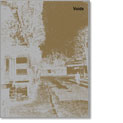
Edité par Mathieu Copeland avec John Armleder, Laurent Le Bon, Gustav Metzger, Mai-Thu Perret, Clive Phillpot.
Publié avec le Centre Pompidou, Paris, et la Kunsthalle Bern.
2009
édition française et anglaise
21,5 x 28 cm (broché)
448 pages (96 ill. coul. et 267 ill. n&b)
39 €ISBN : 978-3-03764-017-3EAN : 9783037640173
Vides. Le symposium.
Avec, entre autres invités : Robert Barry, Françoise Bonardel, Bethan Huws, Roman Ondák ; et les commissaires de l'exposition John Armleder, Laurent Le Bon, Mathieu Copeland, Gustav Metzger, Mai-Thu Perret et Clive Phillpot.
Manifestation exceptionnelle, « Vides » est une rétrospective des expositions vides depuis celle d'Yves Klein en 1958. Dans une dizaine de salles du Musée national d'art moderne, elle rassemble de manière inédite des expositions qui n'ont rigoureusement rien montré, laissant vide l'espace pour lequel elles étaient pensées.
Si toutes ces expositions dont il est fait la rétrospective ont en commun d'avoir fait le choix du vide, elles se différencient par la signification qu'elles lui attribuent. D'Yves Klein à Roman Ondák, en passant par Robert Barry, Art & Language ou encore Maria Eichhorn, chacun des artistes présentés illustre, de différentes manières, souvent complémentaires, le désir de travailler le vide.
De la recherche de sensibilité ou de perceptions inédites à la mise en abyme du principe même d'exposition, de la prise de position politique ou idéologique à la réflexion philosophique, cet ensemble d'expositions, d'apparence similaire, propose une constellation radicale de questionnements et de contestations sous forme de défis à l'institution sacralisante.
Cette rencontre est donc le pendant nécessaire de cette étonnante rétrospective puisqu'elle permettra à ces questionnements de s'expliciter et de se confronter grâce aux interventions et aux discussions menées tout à la fois par des artistes de la rétrospective et par les commissaires.
25 février 2009 - 19h30
Centre Pompidou
Place Georges Pompidou
75004 Paris
Une Exposition Chorégraphiée
Avec Jonah Bokaer, Philipp Egli, Karl Holmqvist, Jennifer Lacey, Roman Ondak, Michael Parsons, and Fia Backstrom & Michael Portnoy. Interprétée par Le Clubdes5. An exhibition by Mathieu Copeland.
Une Exposition Chorégraphiée est une exposition composée exclusivement de mouvements. Pendant un mois et demi, six heures par jour, trois danseurs interprètent les partitions écrites par huit artistes. L’ensemble de ces partitions est orchestré par le commissaire d'exposition qui crée le déroulé général, sorte de mouvement chorégraphique ou musical à plusieurs thèmes.
En l’absence de décor, de lumière dramatique ou de musique, les gestes résonnent dans la galerie déserte. S’enchaînant dans un continuum sans fin, ils se déploient dans l’espace et dans le temps.
Les danseurs, tels des sculptures vivantes, concentrent toute l'attention, bouleversant le rapport au spectateur. La proximité troublante avec les interprètes, et leurs déplacements souvent imprévisibles, obligent à se mettre soi-même en mouvement, à se repositionner en permanence. Une exposition chorégraphiée invite à une expérience inédite de l'espace et de la durée. Elle se forme et se déforme sous nos yeux. Elle ne se fixe jamais sinon dans la mémoire.
Le geste est notre état d’esprit / A gesture is our state of mind
Centre d'art de la Ferme du Buisson
Scène nationale de Marne-la-Vallée
Allée de la Ferme – Noisiel
77448 Marne-la-Vallée Cedex 2
tél : 01 64 62 77 00 / fax : 01 64 62 77 99
contact@lafermedubuisson.com
www.lafermedubuisson.com
Horaires
Vendredi, samedi, dimanche 14h-20h
Accès depuis Paris
RER A, dir. Chessy / Marne-la-Vallée, arrêt Noisiel (20 min)
Porte de Bercy, A4 dir. Marne-la-Vallée, sortie Noisiel-Torcy puis Noisiel-Luzard (15 min)
Le Centre d'art contemporain de la Ferme du Buisson bénéficie du soutien de la Drac Ile-de-France/Ministère de la Culture et de la Communication, du SAN Val-Maubuée et du Conseil Général de Seine-et-Marne. Il est membre des réseaux tram et d.c.a.
‘A Choreographed Exhibition’ is an exhibition curated by Mathieu Copeland and co produced by the Kunsthalle St Gallen (http://www.k9000.ch/) and La Ferme du Buisson (http://www.lafermedubuisson.com/).
L'exposition Continue
Une exposition de Mathieu Copeland pour 2 centres d’art (Circuit & 1m3) avec
David Cunningham,
On Kawara,
Charlemagne Palestine,
et des peintures de Birgir Andresson, Jean-Sylvain Bieth, Francis Baudevin, Michel Castaignet,
John Cornu, Philippe Decrauzat, Noel Dolla, Olivier Mosset, Christian Robert-Tissot, Evi Vingerling,
repeintes de la même couleur que le mur par Claude Rutault.
vernissage le vendredi 3 octobre à 18h
du 4 octobre au 22 novembre 2008
je-ve-sa de 14h à 18h et sur rendez-vous
Concert de Charlemagne Palestine
mercredi 1er octobre à 20h30, Eglise St-François, Lausanne
Concert de David Cunningham et Mika Vainio
samedi 4 octobre à 22h, Le Bourg, rue de Bourg 51, Lausanne
Lecture de One Million Years, On Kawara
chaque samedi à 16h durant l’exposition, Circuit, Lausanne
Lausanne, Switzerland
www.galerie1m3.com & http://www.circuit.li/
WALKING IN THE CITY
Friday October 10th 2008 at 8pm, live discussion between Iain Sinclair, Michael Parsons and Mathieu Copeland on Resonance FM
http://resonancefm.com/archives/352
Photographs courtesy Deborah Bullen
Sunday October 12th 2008 at 11.00am
Finsbury Avenue Square London EC2 (west side of Liverpool Street station)
Michael Parsons Walking Piece***
Philip Corner One Note Once
Michael Parsons will create a new version of his experimental classic Walk, originally written for the Scratch Orchestra in 1969. The performance will take place between 11.00am and 12 o’clock. To participate, meet in the Octagon next to the Richard Serra sculpture at the west entrance to Liverpool Street station at 10.30am. The work by Philip Corner will be performed inside the Richard Serra sculpture at exactly 12 o’clock.
«The architecture geometrically defined by urban planning is transformed into a space by walkers. Space is articulated by the operations that take place within it. It is composed of intersections of mobile elements; it exists when one takes into account vectors of direction, velocities and time variables».
(Michel de Certeau)
A Culture House commission curated by Mathieu Copeland, media partners Resonnance FM
The Saints, and Music & Films by Amy Granat
With Fia Backström
Jutta Koether
Amy O’Neill
Mai-Thu Perret
Emily Sundblad
Stefan Tcherepnin
Angel Turner
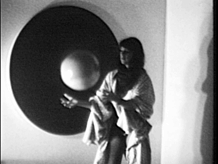
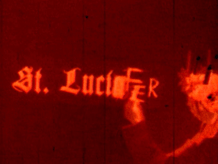
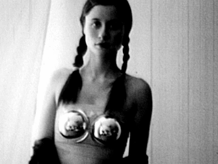
Opening the 26th of April, at 14.00, with ‘Emotional Music’ a performance with Amy Granat, Emily Sundblad and Stefan Tcherepnin.
The exhibition runs until the 14th of June 2008, 10am – 5pm
An exhibition curated by Mathieu Copeland
26 April to 14 June 2008
Sketch Gallery, London
9 Conduit Street
London, W1S 2XG, UK
Le Dojo, La Villa Arson et le laboratoire de mémoires présentent
Une exposition de mémoires
Une discothèque silencieuse
vernissage vendredi 2 mai à 18h
exposition du 3 mai au 9 mai 2008
Exposition collective de & avec BENJAMIN BICHARD, ANNA BYSKOV, ZORA CAHUSAC, MARION CHARLET, CAMILLE DEBRAY, ALYS DEMEURE, MAILYS D.PERRET, LOUP GANGLOFF, SOPHIE GRANIOU, LAURIE GERARDO, YASMINA HATEM, CINDY LELAURIN, SANDRA LORENZI, AURELIE MENALDO, MARYLINE M'GAIDES, STEPHANIE RAIMONDI, COLINE VECTEN, sur une proposition de MATHIEU COPELAND, avec NOËL DOLLA & PASCAL PINAUD
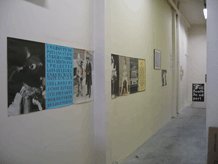
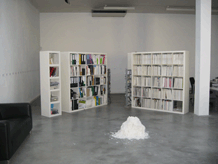
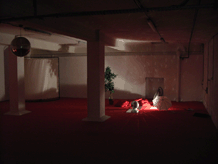
Cette réflexion est née d'une collaboration entre les étudiants de la Villa Arson et Mathieu Copeland, curateur d'exposition.
"Une exposition de mémoire"... s’ouvre sur un paradoxe et propose de penser d'après cette notion générique, comment poser des termes précis pour entrevoir et exposerl’impossible réalité de cette substance.
Penser une exposition comme on écrit une partition, ou la polyphonie des œuvres génère une création homogène et globale... "Une exposition de mémoire" met en place un mouvement auto générateur qui repense la realite d’un centre d’art alternatif niçois, le Dojo.
Les œuvres d'artistes, les archives du lieu et les espaces de travail sont utilisés et réactualisés, générant ainsi de nouvelles productions. "Une discothèque silencieuse" est mise en place et le souvenir de ce lieu unique se fond dans l'installation. Les résidus, les déplacements, les citations éclatent le sens et activent le processus de mémoire.
L'enjeu dépasse ainsi l'idée de représentation, s’offrant la mémoire d’un lieu et l’accumulation de mémoires fictives. S'insérant dans le cadre d'une exposition, cet environnement met en valeur les modes de productions inhérents à chaque engagement artistique : les contextes spatio-temporels, la médiation effective entre l'œuvre et le spectateur, et finalement les traces produites.
Les cartels de toutes les œuvres exposées depuis les débuts du Dojo, enveloppent l’idée de mémoire et invitent les spectateurs à déambuler à travers le lieu.
L’espace du Dojo est fractionné en deux axes symétriques, comme un espace bipolaire se réfléchissant. Le rocher, fil conducteur de toutes les expositions, s’offre comme la mémoire d’une idée, idée énoncée, projet évoqué puis abandonné, dont le souvenir est incarné par une plaque. Un second rocher en sucre conserve le souvenir du premier comme une réminiscence de neige en mai. Des interventions au cours de l'exposition invitent les spectateurs à questionner leur mémoire immédiate de l’œuvre.
LE DOJO
22 bis bd Stalingrad
F-06300 Nice
Tel 04 97 08 28 14
Fax 04 97 08 28 19
www.le-dojo.org
info@le-dojo.org
Le Dojo est ouvert
du lundi au vendredi
de 9h à 18h,
le samedi sur rendez-vous
VILLA ARSON
A Spoken Word Exhibition - Tranzit/Display - 18th of March - 20th of April 2008
tranzitdisplay
resource centre of contemporary art / zázemí současného umění
cordially invite you / vás srdečně zve na
A Spoken Word Exhibition / Mluvvené Slovo
Vito Acconci, Robert Barry, James Lee Byars, Nick Currrie, Douglas Coupland, Karl Holmqvist, Maurizio Nannucci, Yoko Ono, Mai-Thu Perret, Emilio Prini, Tomáš Vaněk, Lawrence Weiner, Ian Wilson
a Series of Spoken Word Events will take place during the course of the exhibition
Spoken Word Events by King Mob (17. 4.), Susan Stenger (18. 4.), Karl Holmqvist (19. 4.) and Fia Backström (20. 4.)
please contact the gallery or visit the gallery website for more information / součástí výstavy je program živých vystoupení zúčastněných umělců
mimo jiné vystoupí Nick Currie aka Momus (18. 3.), Tomáš Vaněk (19. 3.), Boris Ondreička (10.4.), King Mob (17. 4.), Susan Stenger (18. 4.), Karl Holmqvist (19. 4.) and Fia Backström (20. 4.)
pro bližší informace prosím sledujte web www.tranzitdisplay.cz
Exhibitions view - far right still of INSTANT EXTRA+, a spoken word event by Fia Backström
A Choreographed Exhibition / Eine Choreographierte Ausstellung
With Jonah Bokaer, Philipp Egli, Karl Holmqvist, Jennifer Lacey, Roman Ondak, Michael Parsons, and Fia Backstrom & Michael Portnoy. An exhibition by Mathieu Copeland.
‘A Choreographed Exhibition’ is an exhibition only composed of movements. For over a month and a half, three dancers from the Tanzkompanie Theater St. Gallen are present in the kunsthalle during the opening hours to perform in space the choreography of movements, patterns and choreographed gestures, following the scores and instructions as provided by the invited artists, dancers, and choreographers.
In a space where nothing is present but the dancers, in a the gallery left empty, only the opening hours of the gallery (2pm – 6pm expect Saturdays & Sundays from 1pm – 5pm) and the length of the exhibition (each days between Wednesday and Sunday included from the 1st of December 2007 until the 13th January 2008) gives the time (the rhythm?) to all the pieces. ‘A Choreographed Exhibition’ considers choreography and dance, movements in space and in time, as the gestures become an abstraction of forms choreographed in the space of the Kunsthalle. A succession of movements, where ultimately only the memory of these gestures remain.
Roman Ondak (*1966, lives in Bratislava) with his contribution „Insiders“ begins & closes each day of the exhibition, as the dancers are invited to reverse what is expected of them and not perform, asked to ignore their surrounding reality & any spectators whilst wearing their clothes inside-out. The director/conductor of the Tanzkompanie St. Gallen, Philipp Egli (*1966, lives in St. Gallen) creates for the exhibition a piece where the texture of the body echoes the quality of the space, where the dancers begin the piece by choosing randomly a sealed envelop and discover a set of instruction to be performed in space, a piece where the immediate memory of tasks to be realised in space echoes their own memory as they are often invited to remember each others choreography and subsequently perform these. Composer Michael Parsons (*1938, lives in London) re-actualises his seminal ‘Walking Pieces’ first realised on the 2nd of August 1969, and instructs the three dancers with a series of scores written for the exhibition on how to walk straight lines within the spaces of the Kunst Halle, thus generating an open piece of visual music. In a choreography somehow reminiscent of a 1960s experimental theatre, Fia Backstrom (*4th of March 1957, in Stocksund, Sweden) & Michael Portnoy (*1971, both living in New York) in this unique collaboration create a piece about exchange systems, as two dancers perform intelligible primitive tribal moves and bargain for their lives, engaging several times during the day a series of 5 morphemes deriving from the daily updated live stock market report as read by a third dancers who evolves in space similarly to any share evolve in the stock exchange. Karl Holmqvist (*1964, lives in Berlin) creates a polyphony of voices in asking the dancers to repeat, perform, sometime sing lyrics from Songs, creating a medley between Tomorrow from Bugsy Malone, & Who Killed Bambi from The Great Rock’nRoll Swindle, entwined with lyrics of their own liking whilst evolving randomnly in the space of the Kunsthalle. The choreography generated by Jonah Bokaer (*1981, lives in New York) with ‘Three Cases of Amnesia’ writes three movements for any three dancers each realised at different moment during the course of the day, inviting the dancers to play on their memories and movements as they mediate & reveal the space of the Kunsthale, and their bodies and expressions echoes and engages with the space and generates so many germs as movements to come and ultimately disseminate & spread. Creating the transitions between all the pieces, Jennifer Lacey, who lives & works in Paris, developed a large series of instructions linking all the pieces together, inviting the dancers to choose each day the transitions to be realised between all of the pieces, all taken from a large series of choreographed gestures that can either be a humming in space whilst performing their own essential personal & private activities, or at other time an instructions to do nothing or rest, or again as an instruction to engage for a time in a classical & iconic dance move to be performed with closed eyes (…), altogether creating a choreographed piece that intervenes in-between all the pieces, and therefore within the core of the exhibition.
All pieces are performed as the day evolves, yet at any given time the viewers are only confronted to a succession of solo shows, one piece by one artist, as only in the entire time of the day and solely throughout its whole duration is the group exhibition revealed. Similarly to dance & performance, ‘A choreographed exhibition’ is a mode of production that produces no objects, and as such affirms its political standpoint in an oversaturated world. The exhibition considers movements as the means to produce ephemeral art pieces, as the works only exists for the time it takes for the dancers to inscribe them in space. Through their execution in time these pieces generate an exhibition of movements, and thus structure the movements of the exhibition as an ephemeral environment, or in other words, as a choreographed exhibition.
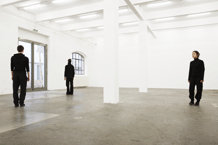
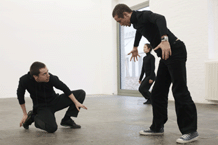
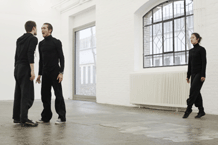
Photographies by Anna-Tina Eberhard
Le geste est notre état d’esprit / A gesture is our state of mind
Kunsthalle St Gallen, Davidstrasse 40, CH-9000 St. Gallen
Open from Wednesday until Sunday: Wed/Thur/Fri: 14-18 ; Sat & Sun: 13-17
‘A Choreographed Exhibition’ is an exhibition curated by Mathieu Copeland and co produced by the Kunsthalle St Gallen (http://www.k9000.ch/) and La Ferme du Buisson (http://www.lafermedubuisson.com/).
A Spoken Word Exhibition, and a Series of Spoken Word Retrospectives
Guest curator Mathieu Copeland presents “A Spoken Word Exhibition” at the Swiss Institute - NY. The exhibition consists of artworks repeated by the Institute‘s staff. By leaving the gallery space empty and making works available only on demand, an exchange is initiated between spectators and the gallery staff. An exhibition of the same nature & material as that of the artworks that it is constituted of, which are words. Artworks only spoken, exchanged as a verbal gesture from one person to another, generating ultimately an exhibition that only last the time it takes to hear it.
Artists contributing to “A Spoken Words Exhibition” include Vito Acconci, Robert Barry, James Lee Byars, Nick Currie (aka Momus), Douglas Coupland, Karl Holmqvist, Maurizio Nannucci, Yoko Ono, Mai-Thu Perret, Emilio Prini, Tomas Vanek, Lawrence Weiner, and Ian Wilson.
Through the artist’s voice and words, The Spoken Word Retrospectives present us with the whole of an artist’s career, generating a mental retrospective in the mind of the one who hears it, as said & seen by the artist. A spoken word retrospective begins with everything, and produces nothing more, only everything.
Artists contributing to “A Series of Spoken Words Retrospectives” include David Medalla and Gustav Metzger.
SCHEDULE FOR LIVE EVENTS, EVERY DAY AT 6PM, 495 BROADWAY 3FL, FREE ENTRANCE:
For more information on the live events, please click here
OPENING : Nov 1 Karl Holmqvist
Nov 2 Michael Portnoy - A Seminar in Sublingual Carnage.
Nov 3 An evening of the book(s)
18.00 : A Reading from Mai-Thu Perret’s the Crystal Frontier
18.30 : 2 or 3 things I know about books, an event by Raimundas Malasauskas with Michael Portnoy & Fia Backström
Nov 4 Robert Barry
Nov 5 Genesis Breyer P Orridge
Nov 6 David Medalla - "Four Aces: Towards a nano theatre of Utter Meaninglessness"
Nov 7 Vito Acconci
Swiss Institute [SI] - 495 Broadway 3rd Floor - New York NY 10012
Biennale d'art contemporain de Lyon, 19 septembre 2007- 6 Janvier 2008- artiste invitée Mai-Thu Perret avec 'An Evening of the Book'
www.biennale-de-lyon.org/bac2007/fran/
L’œuvre pensée pour la biennale par Mai-Thu Perret se trame avec en toile de fond ‘An Evening of the Book (une Soirée pour le Livre)’ (1924), une pièce de théâtre agit-prop. Mis en scène par Vitalii Zhemchuzhnyi, cette propagande pour le livre aux décors et costumes conçus par Varvara Stepanova s’organisait comme une expérimentation dans l’agitation artistique pour les masses par le livre avec des étudiants de l’Académie de l’Education Communiste. De plus, il est à noter le parallèle entre cette histoire et le présent livre d’histoire, autant formellement de par l’importance de leurs graphismes que dans cette volonté d’écrire au présent une histoire en cours. Tout comme ‘An Evening of the Book’ présente le conflit entre les héros des livres pré-révolutionnaire et ceux de la nouvelle révolution, les personnages sortant tous au fur et à mesure des pages d’un livre géant présent sur scène ; Cette biennale se matérialise dans un livre ou l’histoire de l’exposition devient l’histoire d’un livre d’histoire (d’histoires ?). Il nous reste à espérer que tout comme dans cette pièce des années vingt, l’écriture en cours voit la victoire revenir aux héros révolutionnaires.
L’installation ainsi réalisée s’articule autour de trois écrans, trois films de répétitions incessantes de mouvements, un groupe de danseuses reprenant sans cesse des gestes & postures chorégraphiés. Poursuivant une recherche optique et systématique, ces films sont projetés dans un espace tapissé de papier peint réalisé par l’artiste dont les motifs rappellent l’œuvre de Stepanova, un motif qui littéralement se trame jusque sous les films, et leur imprime un léger moiré, comme un flottement.
En opposition à la dictature du présent et la conception de néo, et insistant que nous sommes actuellement dans une époque baroque et rococo, cette pièce s’offre comme une chorégraphie de mouvements. Le signe et le motif sont les leitmotivs dont le mouvement structurent ces films. En échos aux formes géométriques de l’abstraction constructiviste et son actualisation au travers d’une série de films, le présent présent dans ces films est rejoué jusque dans les relations réelles qu’entretiennent les actrices entre elles, dessinant une boucle que celles-ci habitent
Filmstills "An Evening Of The Book", © Mai-Thu Perret, 2007
Mai-Thu Perret’s installation ‘An Evening of the Book’ finds its origins in the agit-prop theatre piece ‘An Evening of the Book’ from 1924. Directed by Vitalii Zhemchuzhnyi, this propaganda for the book whose costume and set was designed by Varvara Stepanova was organised as an experimentation on mass artistic agitation through the book, with the students from the Communist Education Academy.
The installation entitled ‘An Evening of the Book’ is composed of a room featuring three screens, and on each are projected a different film of unceasing repetitions of movements; a group of dancers repeating unremittingly gestures & choreographed postures. Following upon an optical and systematic research, these films are projected in a space covered with a wallpaper designed by the artist, whose motif are reminiscent of Stepanova’s art, a pattern that is also weft literally into the films as a silvery white pattern on white is reproduced on the surface of each screen, giving them a moiré (or shimmering) effect, as if they were floating.
As opposed to the dictatorship of the present and its conception of néo, and insisting that we are currently in a baroque & rococo period, this piece is offered as a choreography of movements. The signs and the patterns are the leitmotivs whose movements structure the films. As an echo to the constructivists’ abstraction of geometrical forms and their actualisation through a series of films, the present present in the film is replayed all the way to the relationship that bound the actress together, drawing a circle that they do inhabit.
An exhibition with Loris Gréaud and Arnaud Michniak, by Mathieu Copeland
Hong Kong, Hong Kong City Hall, 14th of May - 27th of May 2007 - Launch : Sunday the 13th of May, 7.15, Agnes b Cinema / Hong Kong Arts Centre - Screening followed by a public discussion
exhibition views / vues d'exposition
The exhibition appears as a moment frozen in time. A place where the viewers constantly celebrate the opening of an exhibition in a gallery whose size is gradually reduced, and that in turn reduces the view over the city.
The first movement of the exhibition comes with the present DVD that acts as a catalogue. Widely available, it features two new-commissioned films by Loris Gréaud and Arnaud Michniak both filmed in Hong Kong. The film ‘Celador, un goût d’illusion’ by Loris Gréaud is an advertising for a candy that taste of illusion. The film by Arnaud Michniak “Sound take in a hospital” focuses on arrested moments in the midst of a city in constant movement.
The exhibition at the Hong Kong City Hall appears minimal, if not empty. The films realised for the exhibition are shown sporadically throughout the exhibition. Our experience in the gallery is somehow what we are told of these works. There, everything remains, but nothing is left. Nothing seems to happen. The only element that evolves throughout the exhibition is, paradoxically, the space itself. The art is simply everything else.
Film Stills
Une exposition avec Loris Gréaud et Arnaud Michniak, de Mathieu Copeland
L’exposition apparaît comme un moment gelé dans le temps. Un lieu où les spectateurs célèbrent constamment le vernissage d’une exposition dans une galerie dont la taille se réduit graduellement, et qui en retour réduit la vue sur la ville.
Le premier mouvement de l’exposition a lieu avec le présent DVD, qui en devient son catalogue. Largement diffusé, celui-ci présente deux films commissionnés à Loris Gréaud et Arnaud Michniak, tous deux filmés à Hong Kong. Le film ‘Celador, a taste of illusion’ de Loris Gréaud est une publicité pour un bonbon au goût d'illusion. Le film d’Arnaud Michniak ‘Prise de son dans un hôpital’ se concentre sur des mouvements arrêtés au sein d’une ville en mouvement constant.
L’exposition au Hong Kong City Hall apparaît comme minimale, sinon vide. Les films réalisés pour l’exposition sont présentés de manière sporadique dans l’exposition. Notre expérience dans la galerie n’est finalement que ce que l’on nous dit de ces œuvres. Ici, tout demeure, mais rien ne reste. Le seul élément de l’exposition qui évolue est, de manière paradoxale, l’espace lui-même. L’art est simplement tout ce qui est autre.
DVD / Publication ‘Une exposition avec Loris Gréaud & Arnaud Michniak, de Mathieu Copeland’. Un DVD contenant le film de Loris Gréaud ‘Celador, un goût d’illusion’ ; et le film d’Arnaud Michniak ‘Prise de son dans un hôpital’. DVD Toutes Zones (PAL), Couleurs, Son, 4/3, tout public, 15min. Livret 36 pages, couleurs, contenant une sélection de film stills, ainsi qu’une discussion entre Mathieu Copeland, Loris Gréaud, Karl Holmqvist et Arnaud Michniak, Anglais & Français.
Release of the DVD / Publication ‘An exhibition with Loris Gréaud & Arnaud Michniak, by Mathieu Copeland’. A DVD featuring the film by Loris Gréaud ‘Celador, a taste of illudion’ ; and the film by Arnaud Michniak ‘Soundtake in a hospital’. DVD All zones (PAL), Colour, Sound, 4/3, all public, 15min. Booklet 36 pages, colour, featuring a selection of film stills, and a discussion between Mathieu Copeland, Loris Gréaud, Karl Holmqvist and Arnaud Michniak, English & French.
Please contact info@mathieucopeland.net
« Exhibitions’ Ruins / Emotional Landscapes »
« Tilfinningalandslag (rotnandi sýning) »
With / Sýningin er unnin á grunni verka frá eftirfarandi listamönnum
Birgir Andrésson, Stefan Brüggemann, Nicolas Garait, Loris Gréaud, Elin Hansdottir, M/M (Paris) & Gabriela Fridriksdottir, Gustav Metzger, Jeremy Millar, Francois Morellet, Olivier Mosset, & Claude Rutault.
An exhibition by / Sýningarstjóri Mathieu Copeland.
At the SAFN Collection / Í Safni; samtímalistasafni, Reykjavik, 17/03/2007 – 12/05/2007
“The Movement of People Working”
An exhibition of the films by Phill Niblock,
Curated by Mathieu Copeland
“In film, I am interested in eliminating film time (editing time) and montage, sequencing, narrative line, development, plot, all of the things usually relevant to film, and concentrating on stasis, reiteration on a single idea”.
Phill Niblock
The series of films The Movement of People Working by intermedia artist, minimalist composer, filmmaker and photographer Phill Niblock (who was born in 1933 and lives and works in New York and Ghent, Belgium) portray human labour in its most elementary form. Filmed on 16mm stock in locations including Peru, Mexico, Hungary, Hong Kong, Brazil, Lesotho, Portugal, Sumatra, China (video) and Japan (video), The Movement of People Working focuses on work as a choreography of movements and gestures, dignifying the mechanical yet natural repetition of labourer’s actions.
A wide selection of Niblock's slowly evolving, harmonically minimalist music, realised between 1968 and 2006, are played back in the gallery during the projections, the sound level of these compositions allowing a visceral experience of the long drones and inhabit the ringing, beating overtones. The layering of tones echoes the repetitions of the workers' actions; the evolution of the films on each screen (changing throughout the day), combined with a program that randomly plays back different music pieces, results in a constant renewal of forms, continuously offering the exhibition of new juxtapositions of sound and image.
Images © Phill Niblock
AN INTERVIEW WITH PHILL NIBLOCK (22/11/2006)
The opening on January 20th featured flautist/bassist Susan Stenger (Band Of Susans/Big Bottom) and guitarist Robert Poss (Band Of Susans), long-time performers of Niblock's music, playing 4 pieces (some of which were composed especially for them).
Sketch Gallery, London, 20th of January until the 10th of March 2007.
IT IS WITH GREAT PLEASURE THAT WE ANNOUNCE THE LAUNCH OF THE SHOW TITLES WEBSITE. ACCOMPANYING THE EXHIBITION ‘THE TITLE AS THE CURATOR’S ART PIECE’, AN EXHIBITION THAT USES ONE OF THE SHOW TITLES WRITTEN BY MEXICAN BORN, LONDON BASED ARTIST STEFAN BRÜGGEMANN, THIS WEBSITE OFFERS THE POSSIBILITY TO VIEW, AND TO HEAR, ALL 728 SHOW TITLES WRITTEN TO DATE.
THE SHOW TITLES IS A WORK IN PROGRESS BY STEFAN BRÛGGEMANN OF TITLES FOR EXHIBITIONS. FREELY AVAILABLE, THESE ARE TO BE USED AS ONE WISH. WITHOUT ANY NEED TO ASK FOR ANY AUTHORISATION, THESE ARE TO BE USED AS THE SHOW TITLE, AND CREDITED AS AN ART PIECE BY STEFAN BRÛGGEMANN (SHOW TITLE, #XXX BY STEFAN BRÜGGEMANN). A COPY OF THE INVITATION CARD, AND ANY PRINTED MATERIAL, IS TO BE SENT TO THE FOLLOWING ADDRESS: BLOW DE LA BARRA, 35 HEDDON STREET, W1B 4BP, LONDON, UK.
Online now.
The title as the curator's art piece* A summer Show by Mathieu Copeland
A painting exhibition with Jaroslaw Flicinski & Claude Rutault
A spoken word exhibition with Douglas Coupland, Nick Currie (aka Momus), Karl Holmqvist, Tomas Vanek, Lawrence Weiner & Ian Wilson
*Show title #347, by Stefan Brüggemann
Exhibition running from the 21st of June until the 2nd of September
Blow de la Barra, 35 Heddon Street, London W1B 4BP
Tel + 44 (0) 2077347477 info@blowdelabarra.com
A publication accompanies the exhibition featuring discussions with artist and musician Nick Currie (aka Momus), curator Raimundas Malasauskas, and artist Claude Rutault.
The audio extracts featured on the wesite were repeated (not performed) by gallerist Pablo Leon de la Barra to curator Raimundas Malasauskas at Blow de la Barra on the 25th of Jully 2006.
Soundtrack composed by/composée par Susan Stenger [Band of Susans] with contributions by/avec des contributions de Robert Poss [Band of Susans] , Alan Vega [Suicide], Alexander Hacke [Einstürzende Neubaten], F.M. Einheit [ex Einstürzende Neubaten], Will Oldham [Palace Music, Bonny Prince Billy], Kim Gordon [Sonic Youth], Mika Vainio [Pan Sonic], Bruce Gilbert [Wire], Ulrich Krieger, Warren Ellis [The Dirty Three, The Bad Seeds], Jim White [The Dirty Three], Jennifer Hoyston [Erase Errata], Andria Degens (Pantaleimon), Spider Stacy [Pogues]
Paintings by/Peintures par John Armleder, Steven Parrino
Feature film by/Film par Kristian Levring
An exhibition by/Une exposition de Mathieu Copeland
Audio excerpt from Soundtrack for an Exhibition :
Exhibition View / Vues d'exposition :
soundtrack for an Exhibition (fr - eng) - 8th March until 11th June 2006 - Musée Art Contemporain Lyon
EA C / Expat Art Centre
EA C / Expat Art Centre is an ongoing exhibition that takes place when the art centre, the museum... is closed, inserting itself between two exhibitions. With Brian Eno, Pierre Huyghe, Ben Kinmont, Claude Leveque, Didier Marcel, Olivier Mosset, Shimabuku, Dan Walsh, Ian Wilson. An exhibition by Mathieu Copeland. PDF Leaflet of the exhibition (English - Francais - Polish - Lithuanian - Estonian - Chinese)
Exhibitions Views / Vues d'expositions :
Exhibitions Views: ICA London, Musée Art Contemporain Lyon, Muzeum Sztuki Lodz, CAC Contemporary Art Centre Vilnius, Kunstihoone Tallinn. © The Artists & Mathieu Copeland.
David Cunningham / Sebastien Roux
Wall paper music - Sebastien Roux (LOT Bristol)
Exterior - David Cunningham (AA London)
Meanwhile... across town - Cerith Wyn Evans
Meanwhile... across town - Cerith Wyn Evans (Centre Point London)
"Meanwhile…across town", by Cerith Wyn Evans, permeated the centre of London with a Morse code message transmitted from the neon signs of the landmark Centre Point Tower on Oxford Street. Produced by Forma and curated by Mathieu Copeland, witnessed by hundreds of thousands of people who see the Centre Point Tower from across London every day, Wyn Evans used the letters 'o' and 'i' from Centre Point's signs to transmit an extract from The Visible and the Invisible, an unfinished book by the French existentialist philosopher, Maurice Merleau-Ponty [1908-1961]. The building may be seen as a host organism infected with a virus - the code of a dying language that has taken up temporary residence. The text became buried in the urban landscape, where the pulsating narrative of the Morse code signal might even suggest that every other flashing light might be beaming out its own story.
This invasion of the social fabric of the City was at the core of the artist's intentions. "Meanwhile…across town" appeared as an elegant and subtly perverse way of pointing to no more than the communication itself; through the archaic communication tool of Morse code, broadcasted across town, its message became, ultimately, temporarily, an intrinsic part of the cityscape.